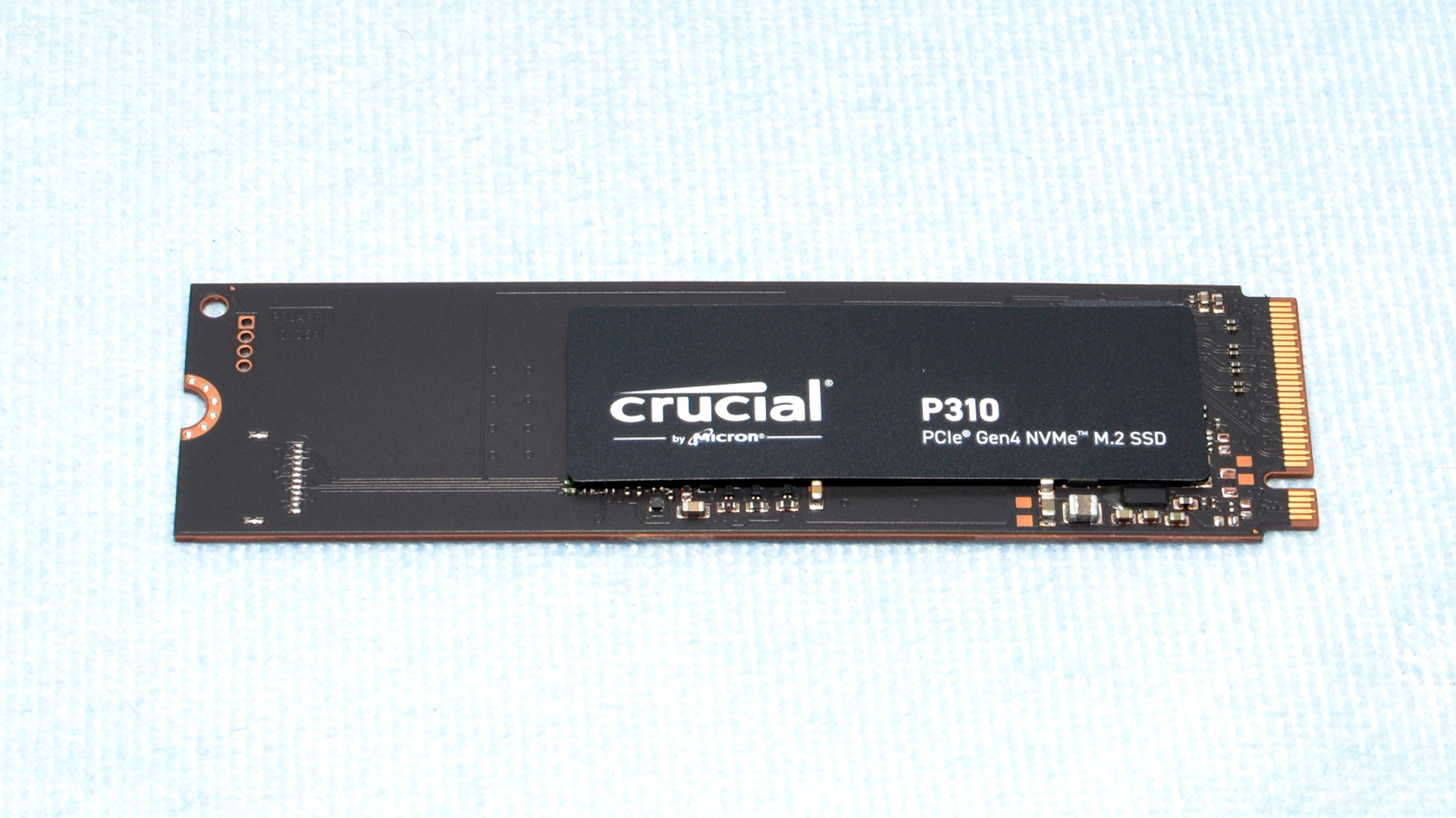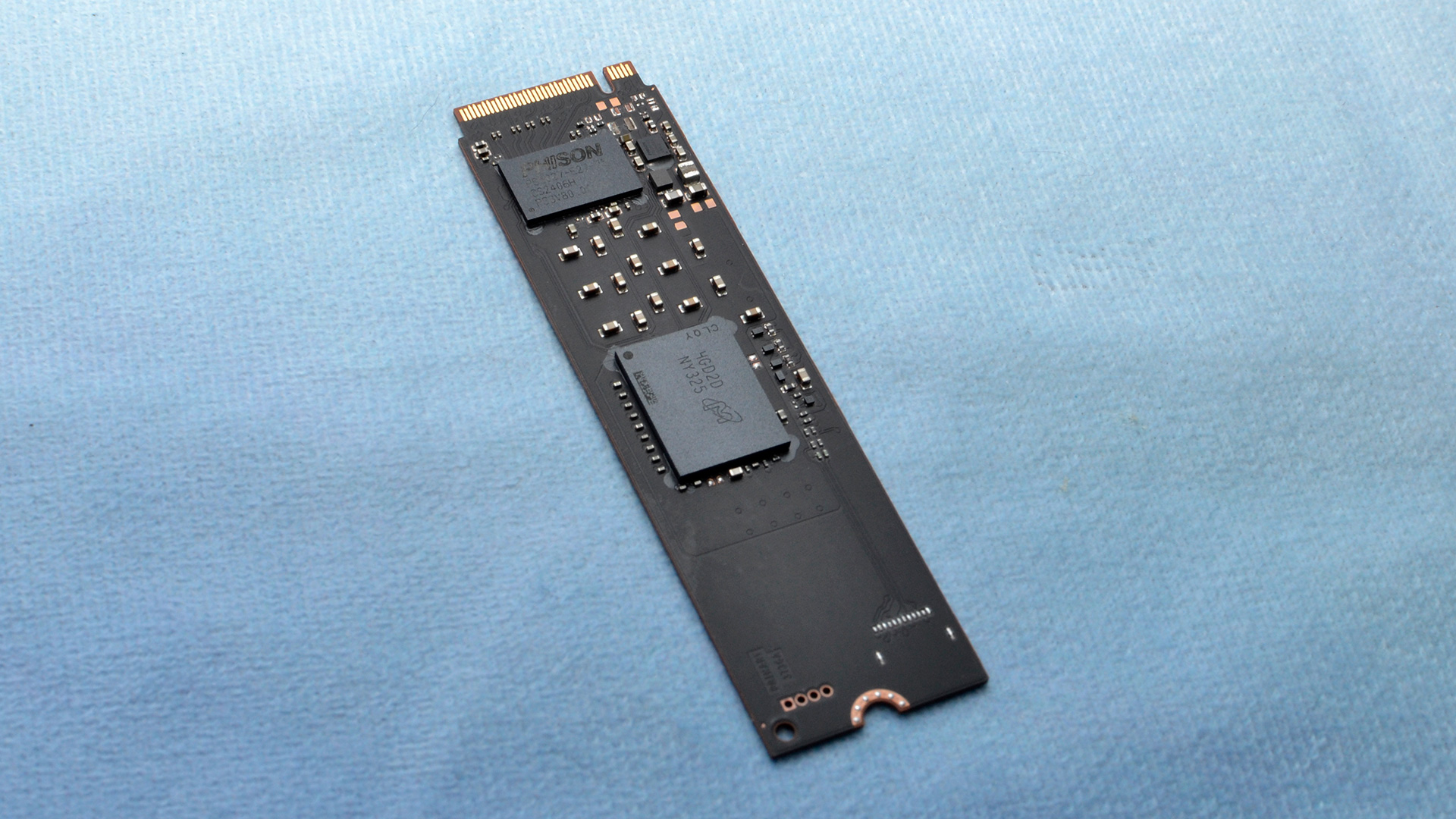Why you can trust Tom's Hardware
Comparison Products
The P310 has stiff competition, which only helps demonstrate how far budget drives have come. The fastest PCIe 4.0 drives are old now, but they're still performant even if they're also less power efficient. These include the SK hynix Platinum P41, the Samsung 990 Pro, and the WD Black SN850X. When bringing things down to four channels for better efficiency, we have Crucial’s T500 with DRAM, the new Samsung 990 EVO Plus without DRAM, and the Silicon Power US75. The last one shares hardware with many popular, “high-end” budget SSDs on the market with 232-Layer TLC flash but no DRAM.
Samsung’s 990 EVO is a step further down, filling in for the slower budget drives. In the opposing direction, we have the Phison E31T ES, the basis of budget PCIe 5.0 drives that will improve upon existing designs. The true high-end includes drives like the Crucial T705 and the Adata Legend 970 Pro that are in a class of their own, but cost more as a result.
Trace Testing — 3DMark Storage Benchmark
Built for gamers, 3DMark’s Storage Benchmark focuses on real-world gaming performance. Each round in this benchmark stresses storage based on gaming activities including loading games, saving progress, installing game files, and recording gameplay video streams. Future gaming benchmarks will be DirectStorage-inclusive and we also include notes about which drives may be future-proofed.
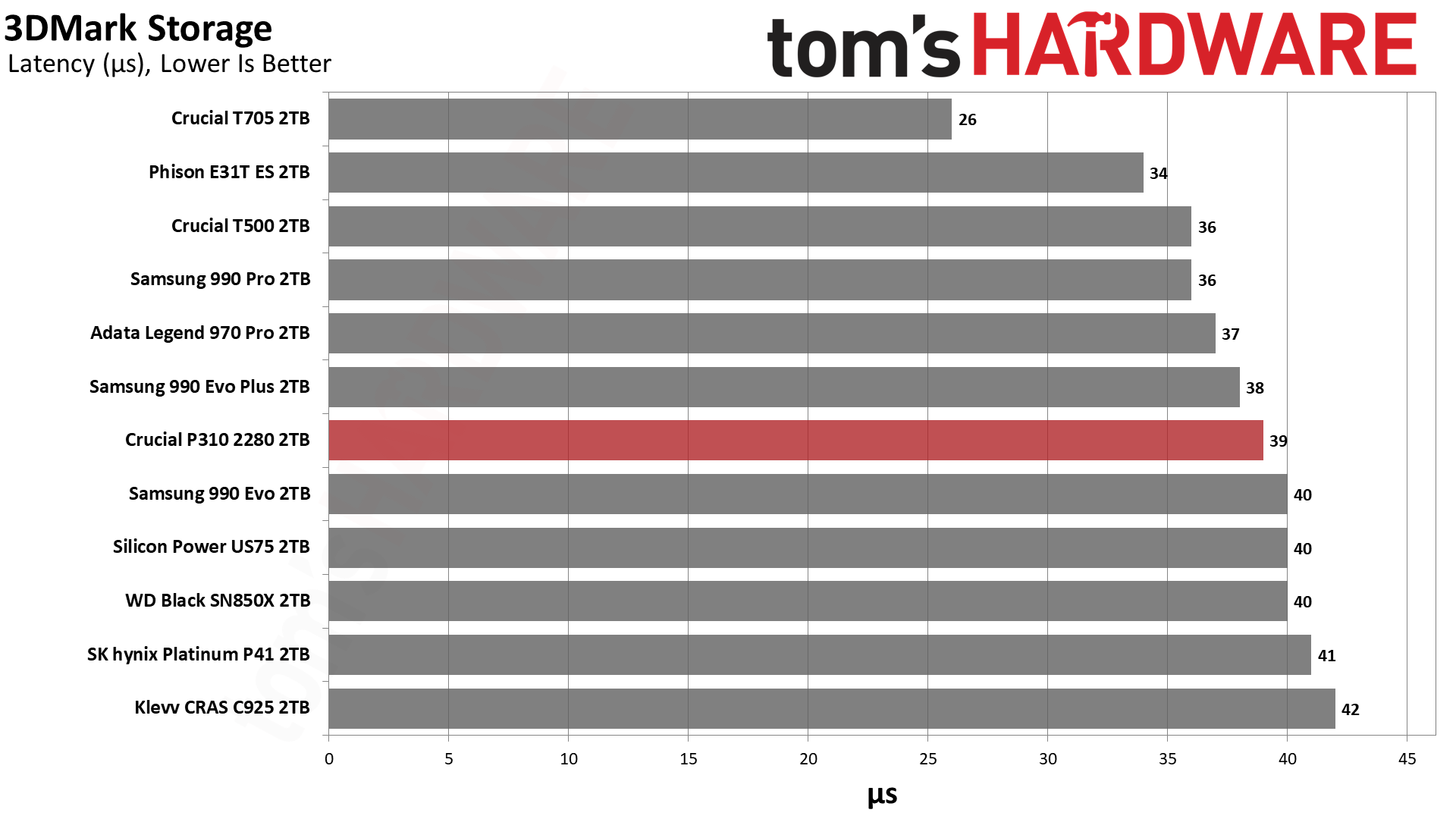
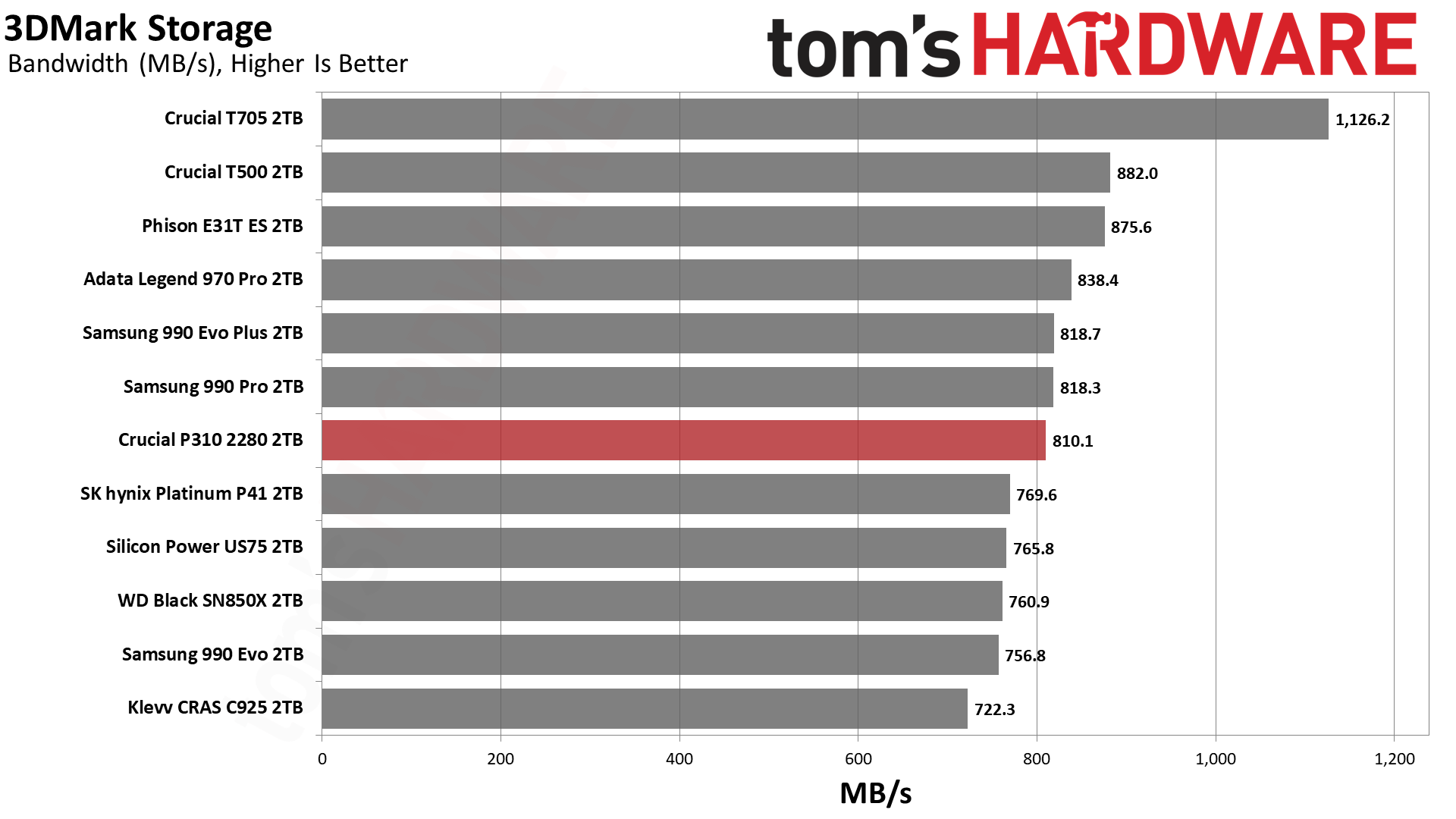
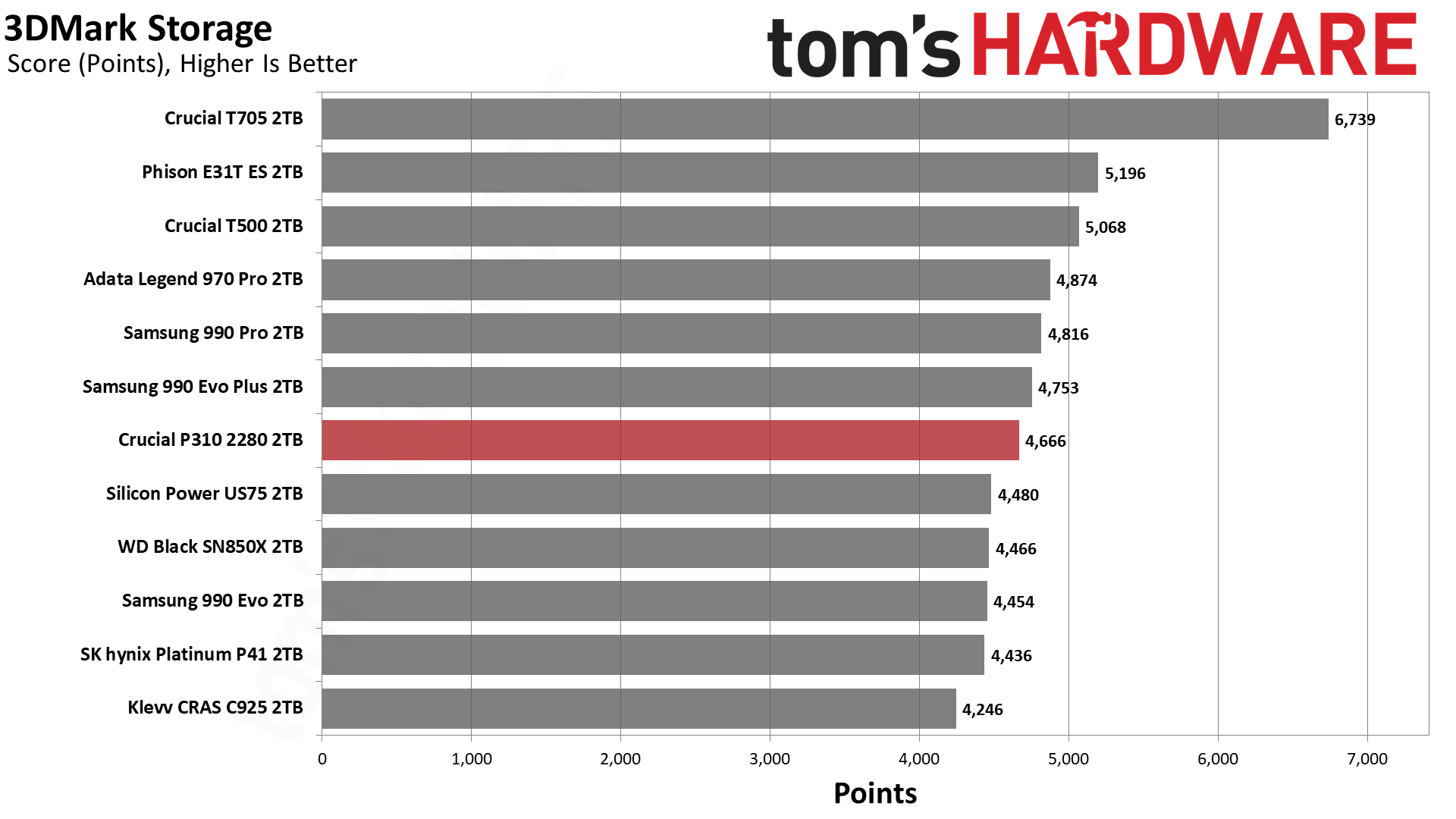
The P310 2280 lands right in the middle of the pack. This is impressive as it beats drives like the SN850X, but it's not able to keep up with some other drives. Considering it’s DRAM-less, this is a good result. Keep in mind that performance on a fuller drive can drop as there's less spare area to work with.
Trace Testing — PCMark 10 Storage Benchmark
PCMark 10 is a trace-based benchmark that uses a wide-ranging set of real-world traces from popular applications and everyday tasks to measure the performance of storage devices. The results are particularly useful when analyzing drives for their use as primary/boot storage devices and in work environments.
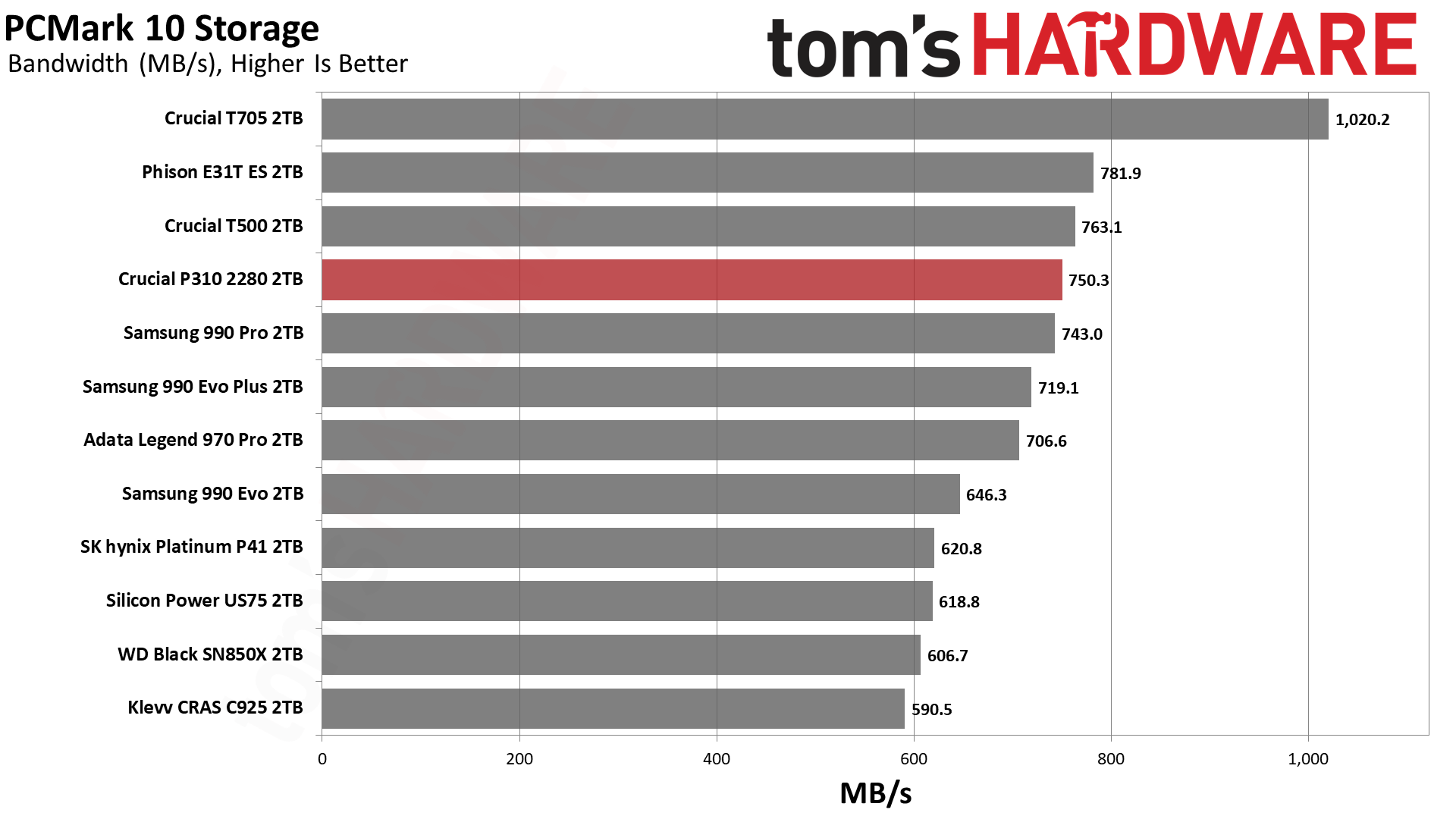
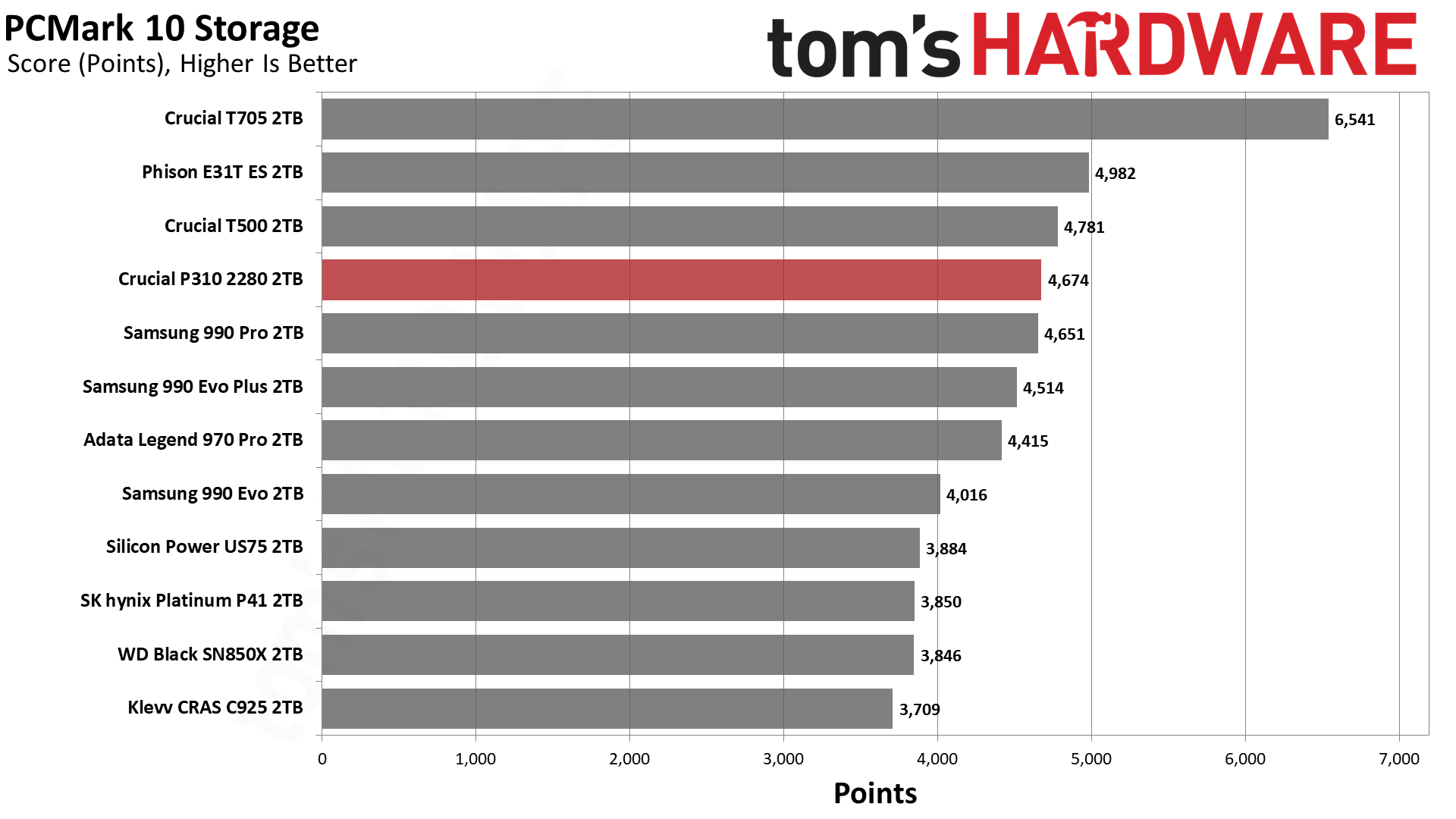
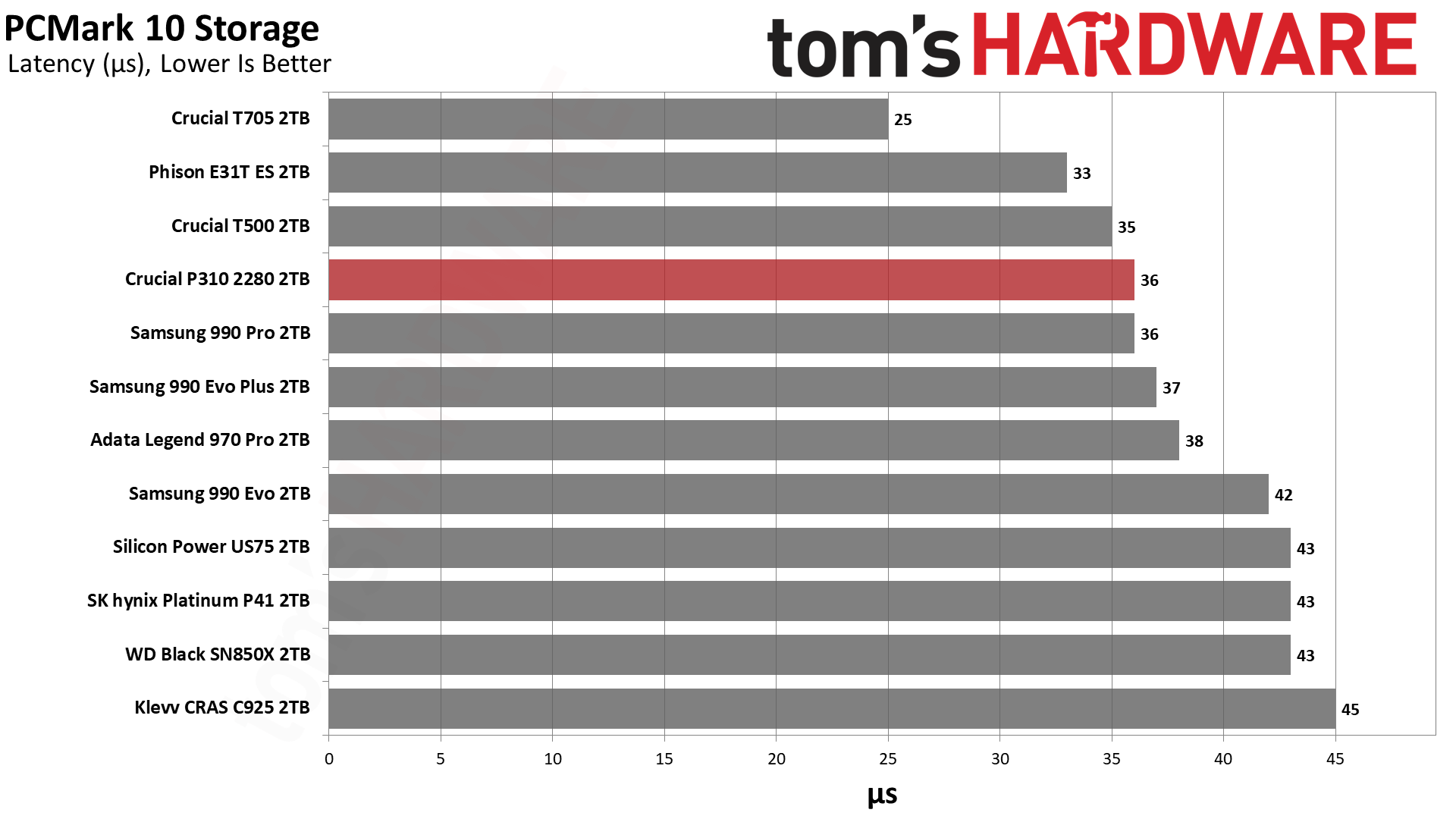
The P310 2280’s showing in PCMark 10 is even better. Here it’s only behind the T500, which has DRAM and TLC flash of the same generation. Crucial doesn’t want to cannibalize its own products but that shouldn’t be a problem as anyone who wants DRAM and/or TLC flash will go with the T500. Both the T500 and P310 are excellent choices for laptop users with the T500 leaning enthusiast, but PCMark shows that for many workloads they perform similarly.
Console Testing — PlayStation 5 Transfers
The PlayStation 5 is capable of taking one additional PCIe 4.0 or faster SSD for extra game storage. While any 4.0 drive will technically work, Sony recommends drives that can deliver at least 5,500 MB/s of sequential read bandwidth for optimal performance. In our testing, PCIe 5.0 SSDs don’t bring much to the table and generally shouldn’t be used in the PS5, especially as they may require additional cooling. Check our Best PS5 SSDs article for more information.
Our testing utilizes the PS5’s internal storage test and manual read/write tests with over 192GB of data both from and to the internal storage. Throttling is prevented where possible to see how each drive operates under ideal conditions. While game load times should not deviate much from drive to drive, our results can indicate which drives may be more responsive in long-term use.
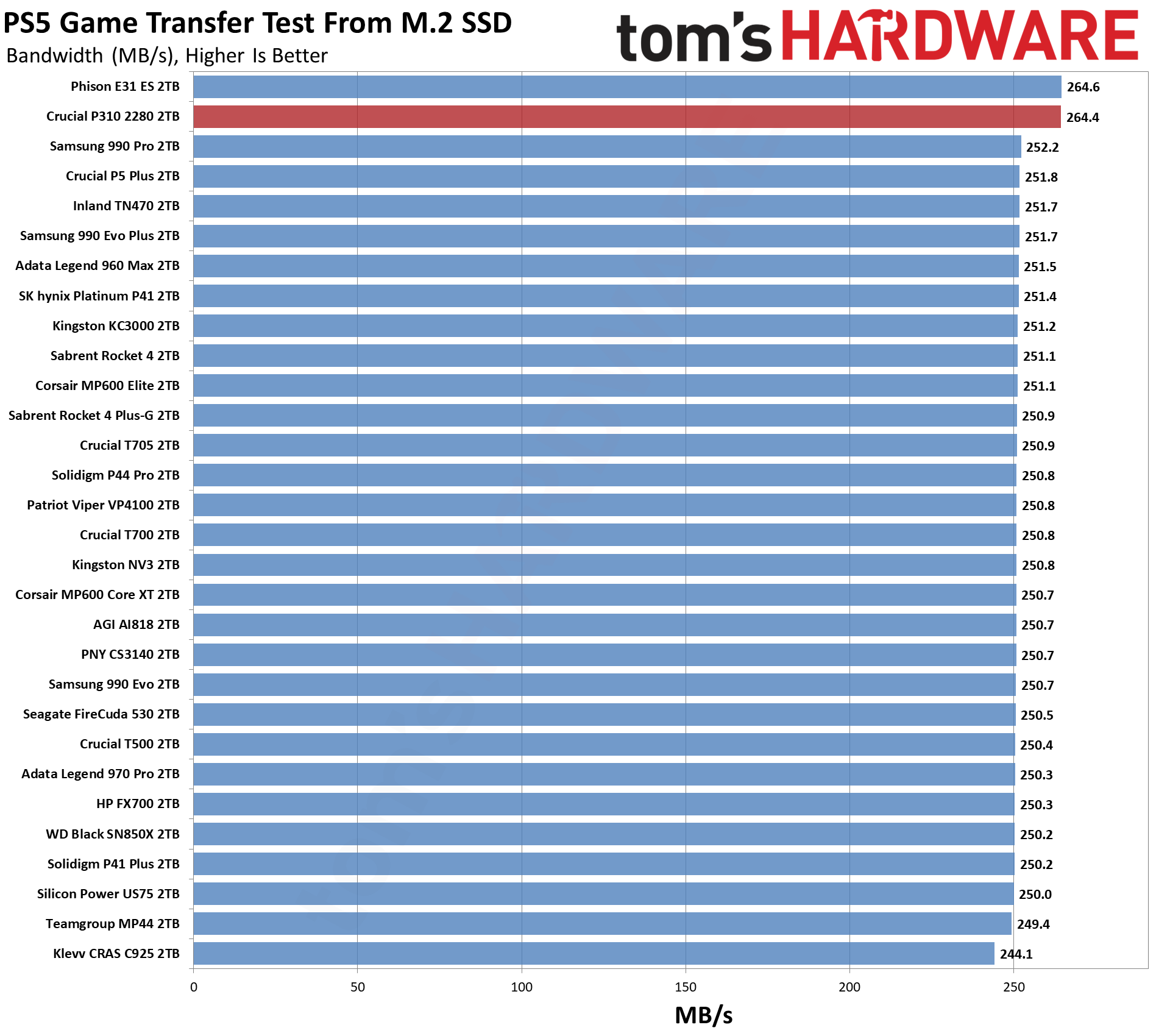
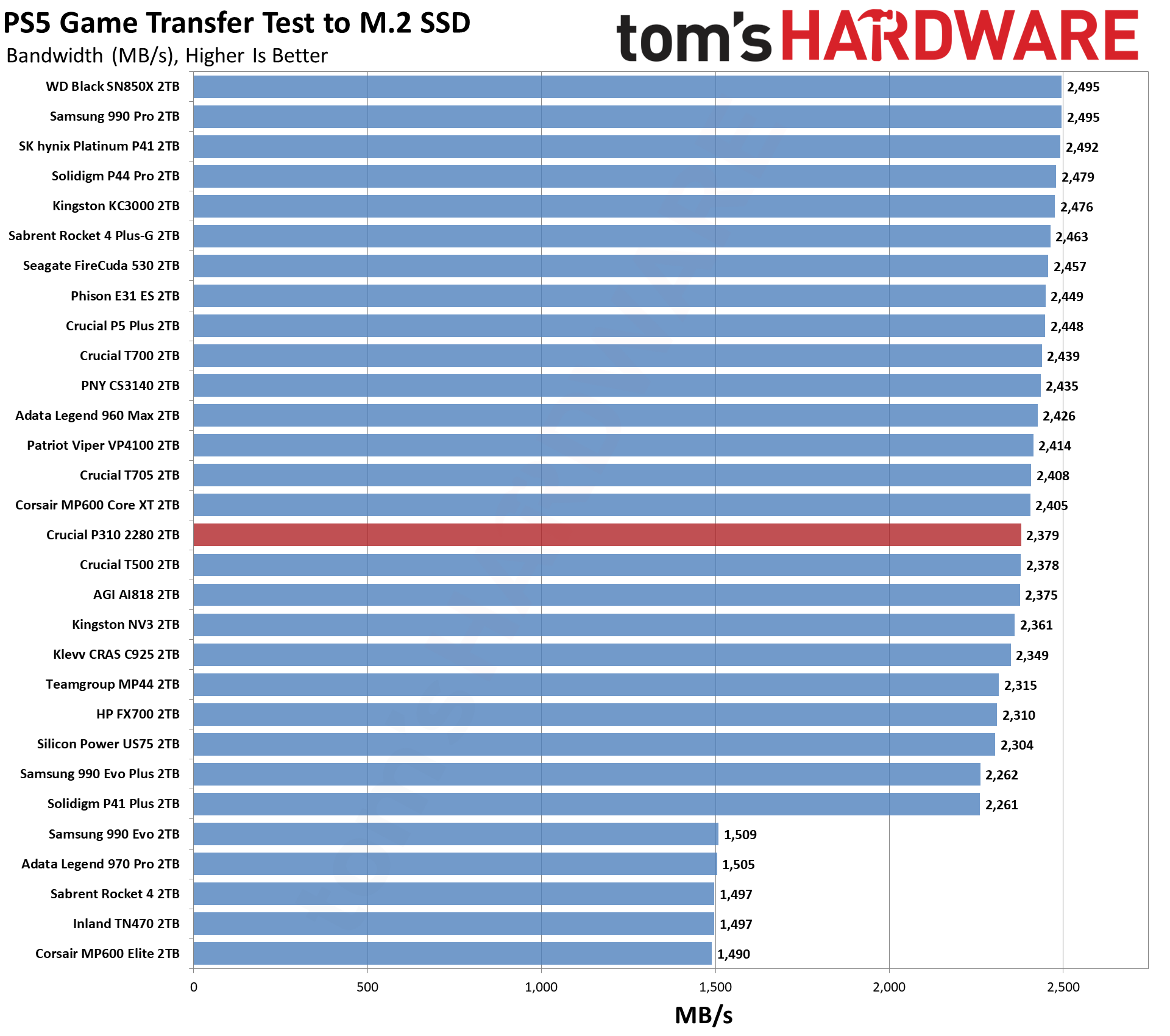
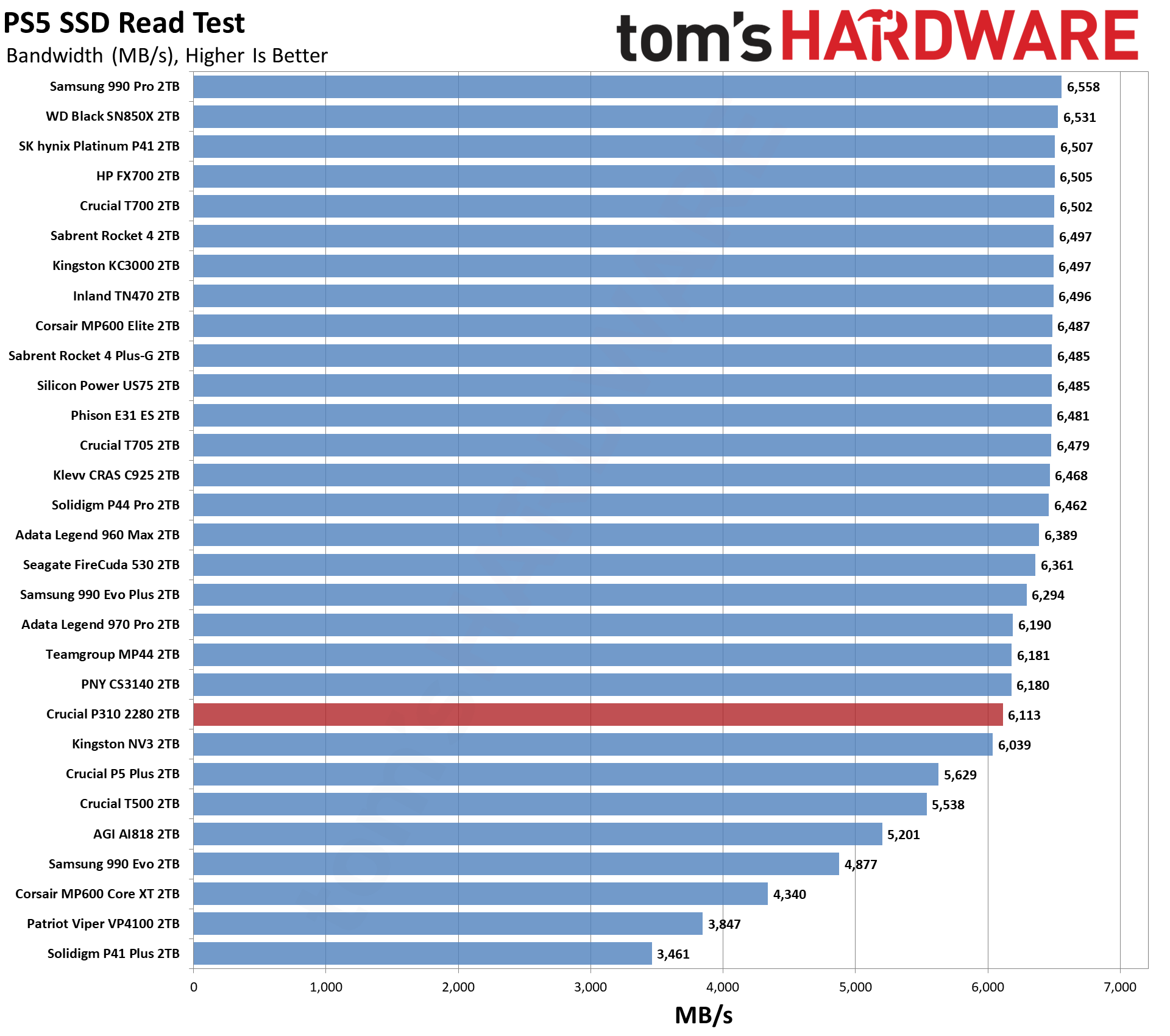
The P310 2280 could be a good choice for a PS5 drive, if price comes down. If you want 4TB you'll have to look elsewhere, and the P310 500GB probably isn’t a good idea either — you could fill that with two or three larger games these days. It makes the most sense at 2TB and there’s a lot of competition there. At that point, it often comes down to whatever drive is least expensive at the moment. Assuming you at least want something at the upper end of PCIe 4.0 performance, right now you would be better off with the Klevv CRAS C925, MSI Spatium M482, and some others.
Get Tom's Hardware's best news and in-depth reviews, straight to your inbox.
Transfer Rates — DiskBench
We use the DiskBench storage benchmarking tool to test file transfer performance with a custom, 50GB dataset. We write 31,227 files of various types, such as pictures, PDFs, and videos to the test drive, then make a copy of that data to a new folder, and follow up with a reading test of a newly-written 6.5GB zip file. This is a real world type workload that fits into the cache of most drives.
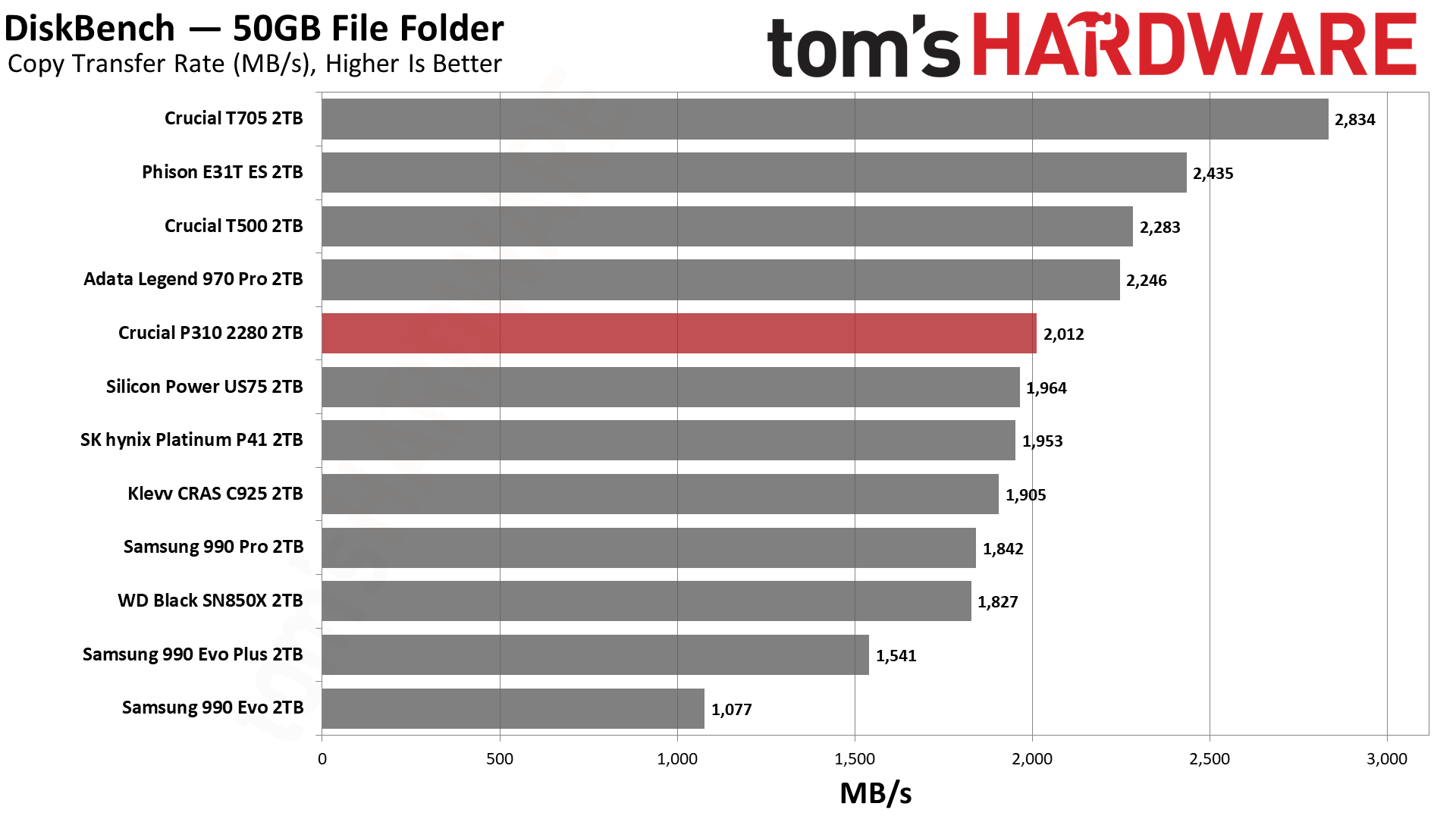
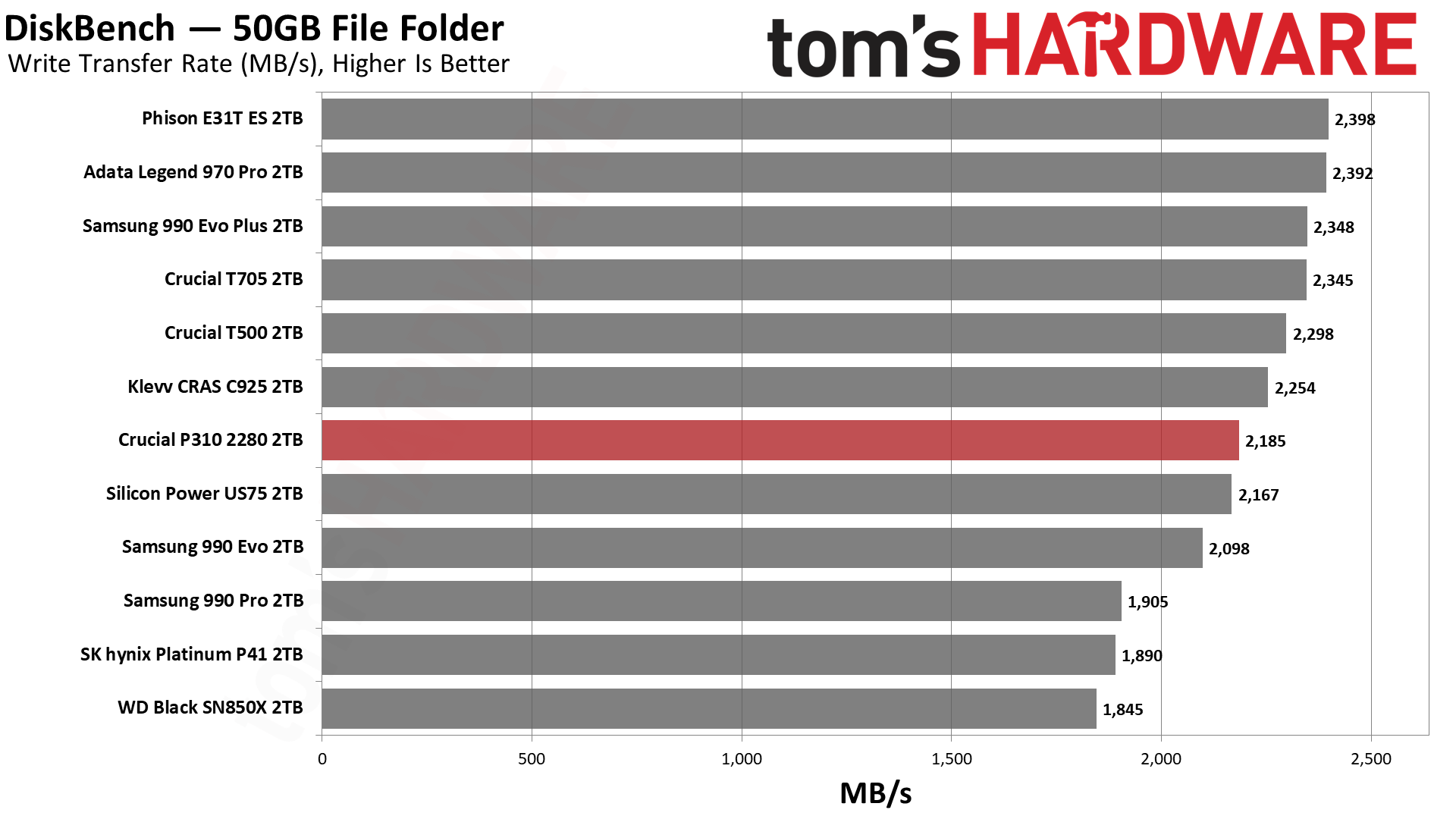
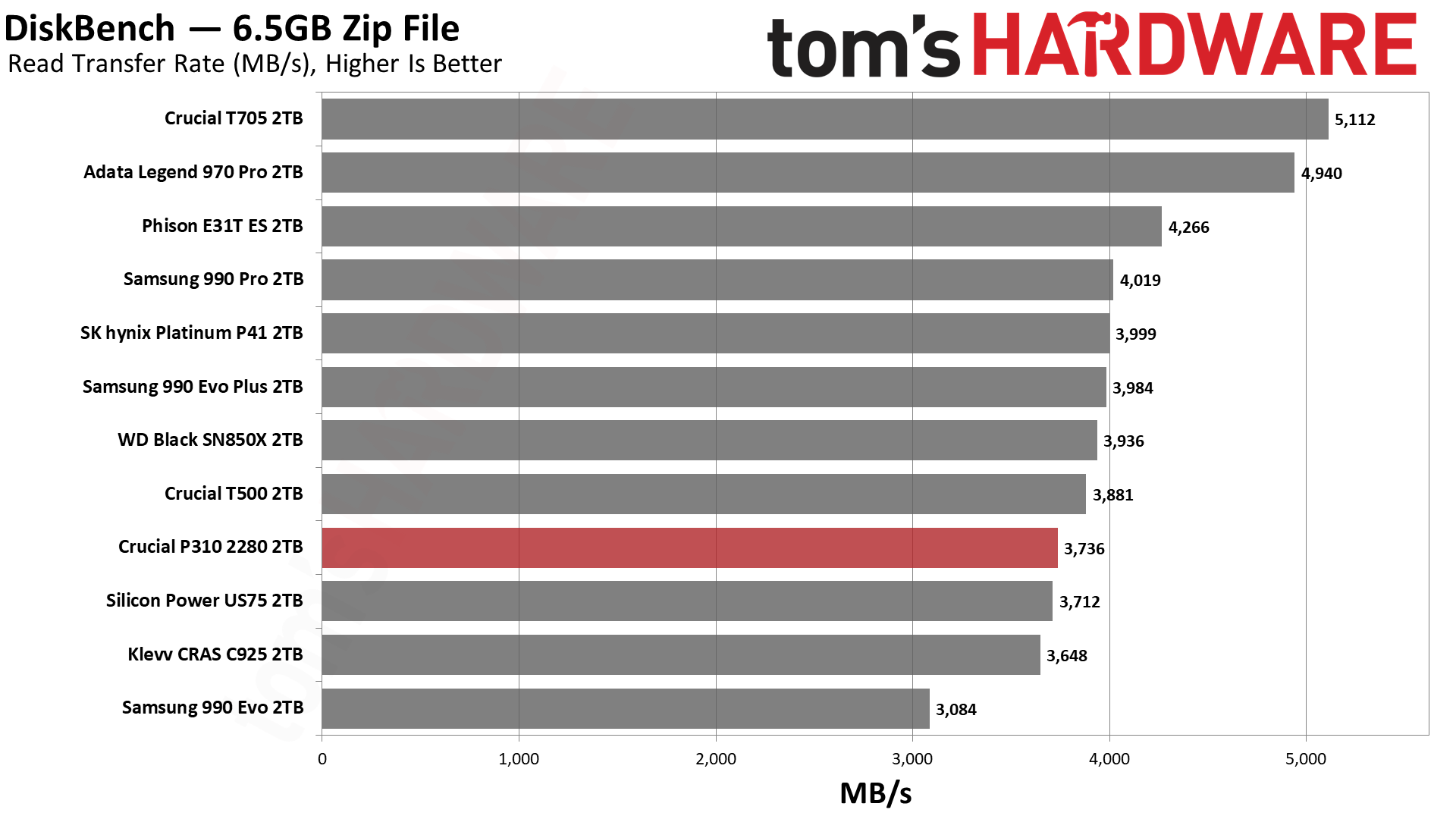
The P310 2280 does well in DiskBench, with copy performance second among the tested PCIe 4.0 drives, only falling behind the T500. Both drives push the boundaries of 4.0 with same-generation flash, but QLC flash has a lower write performance ceiling. Performance here is good enough — within the large pSLC cache, remember — to compete even with higher-end drives like the SN850X and 990 Pro.
Synthetic Testing — ATTO / CrystalDiskMark
ATTO and CrystalDiskMark (CDM) are free and easy-to-use storage benchmarking tools that SSD vendors commonly use to assign performance specifications to their products. Both of these tools give us insight into how each device handles different file sizes and at different queue depths for both sequential and random workloads.
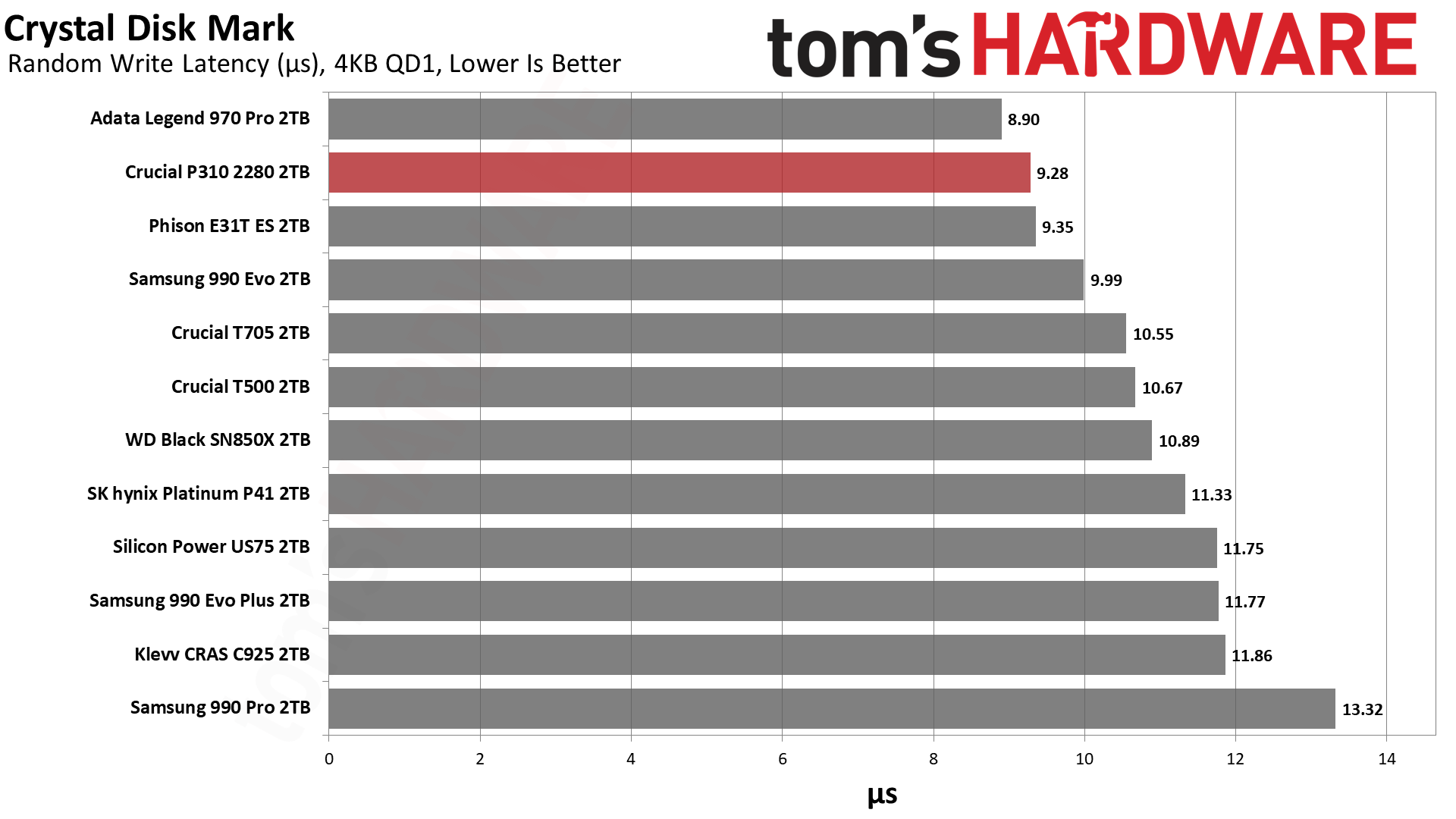
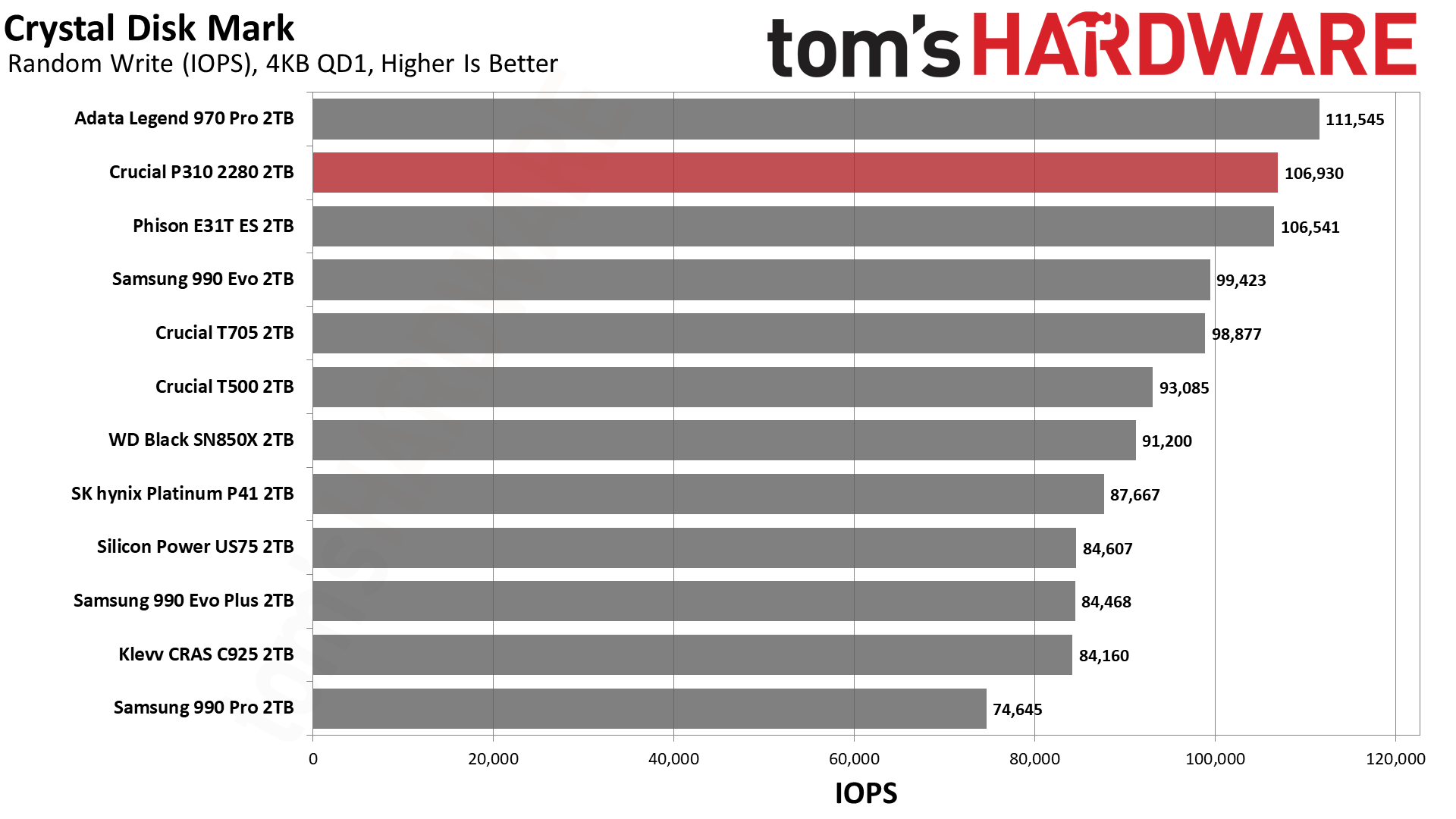
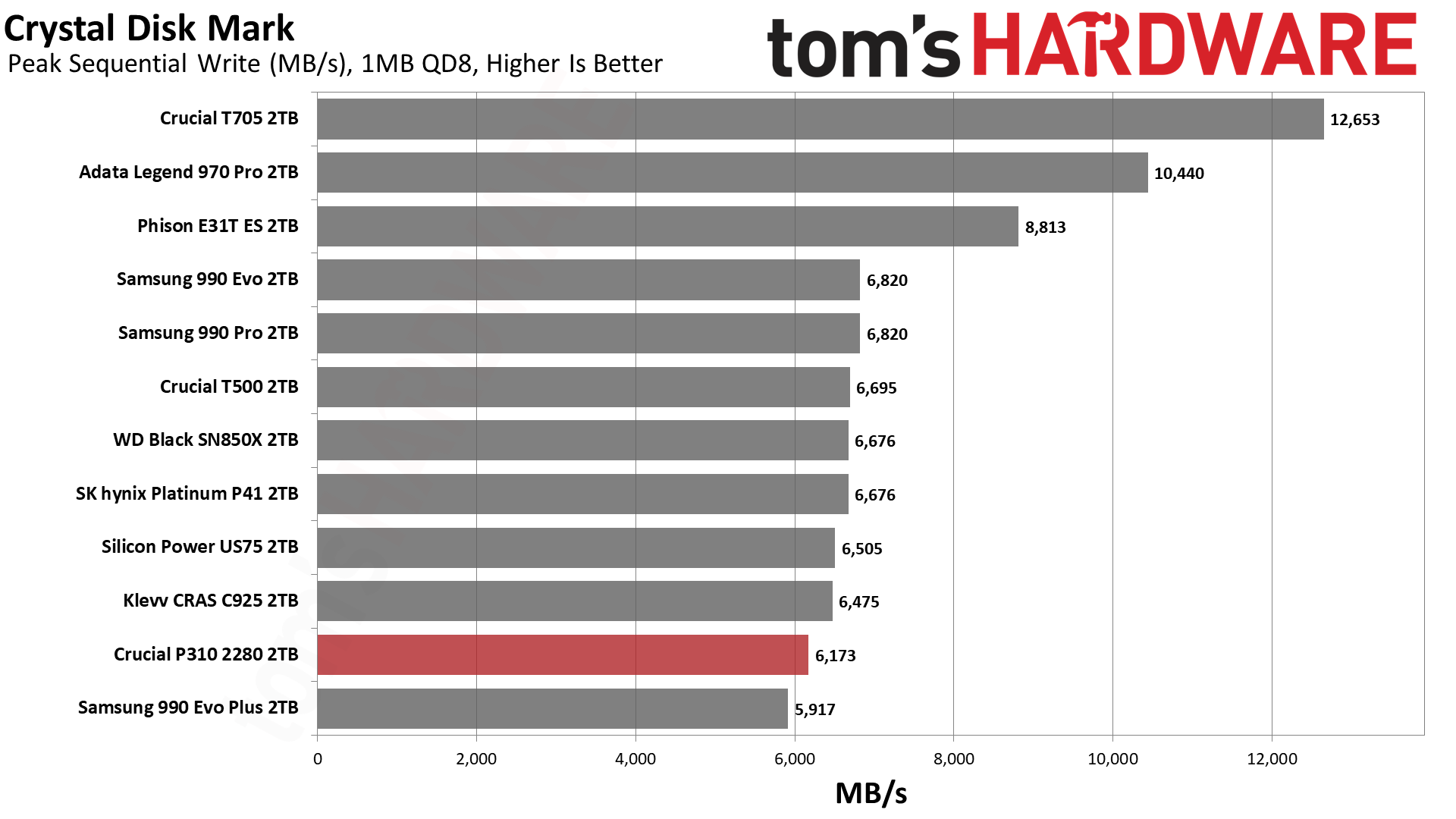
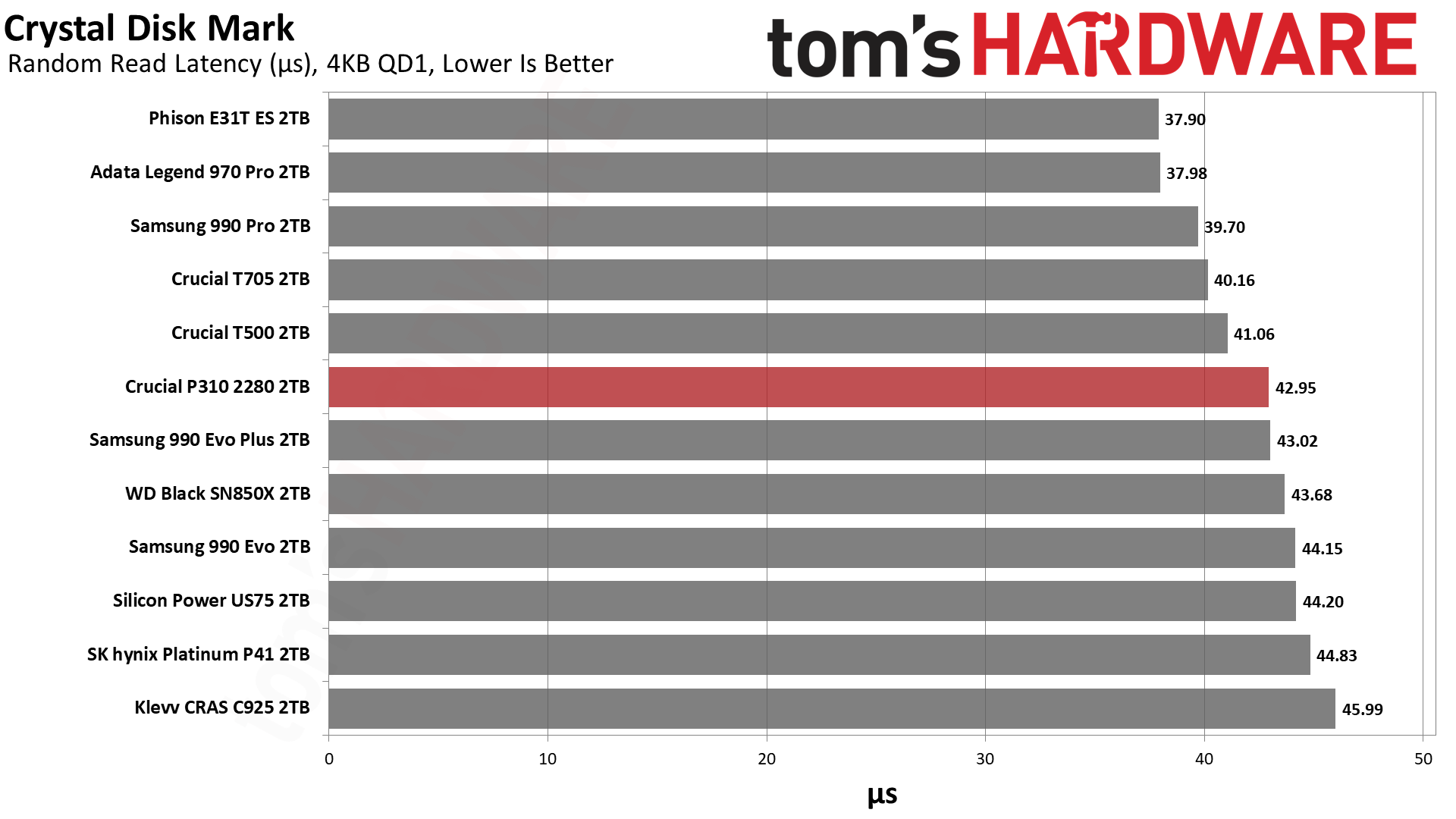
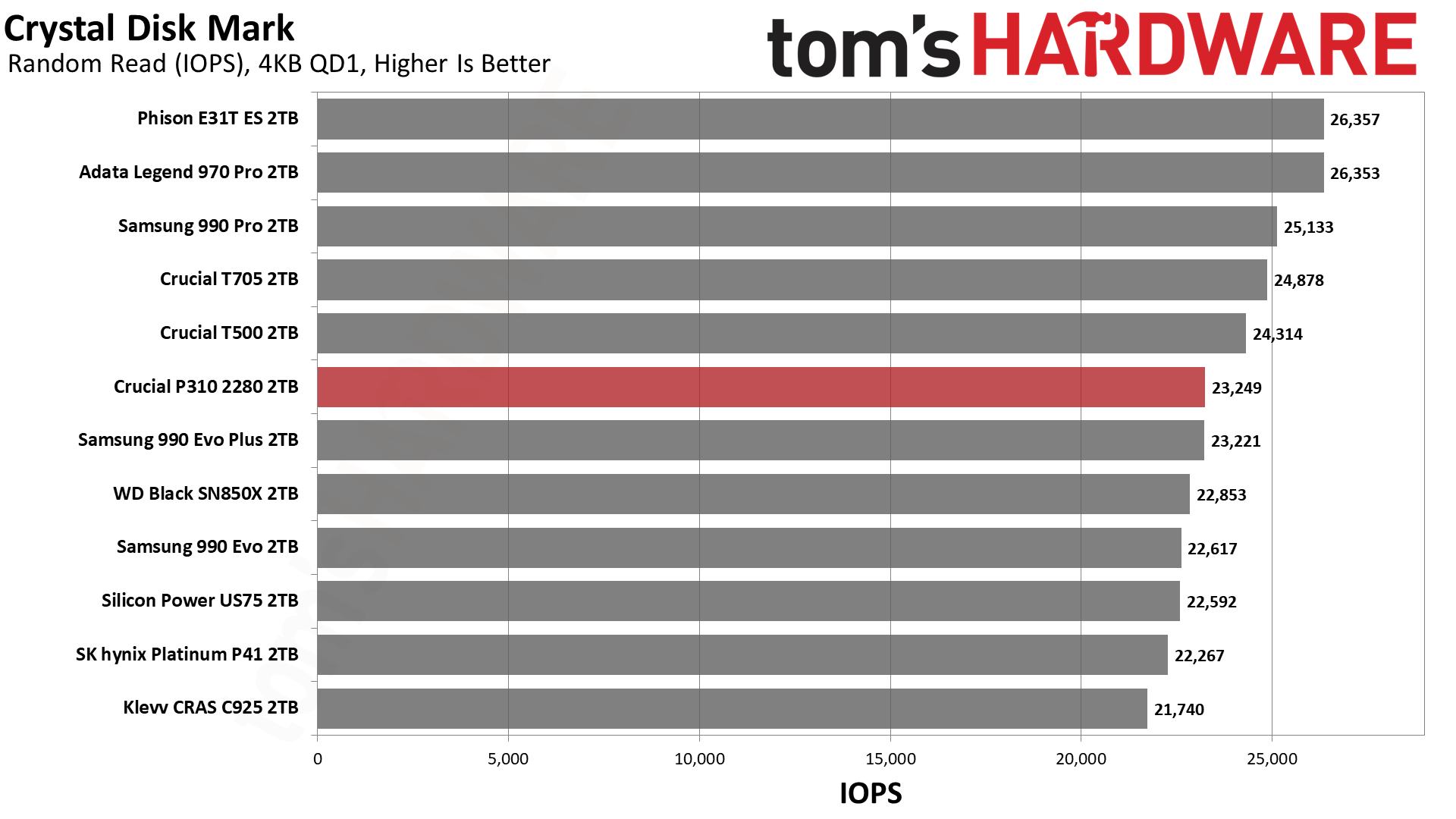
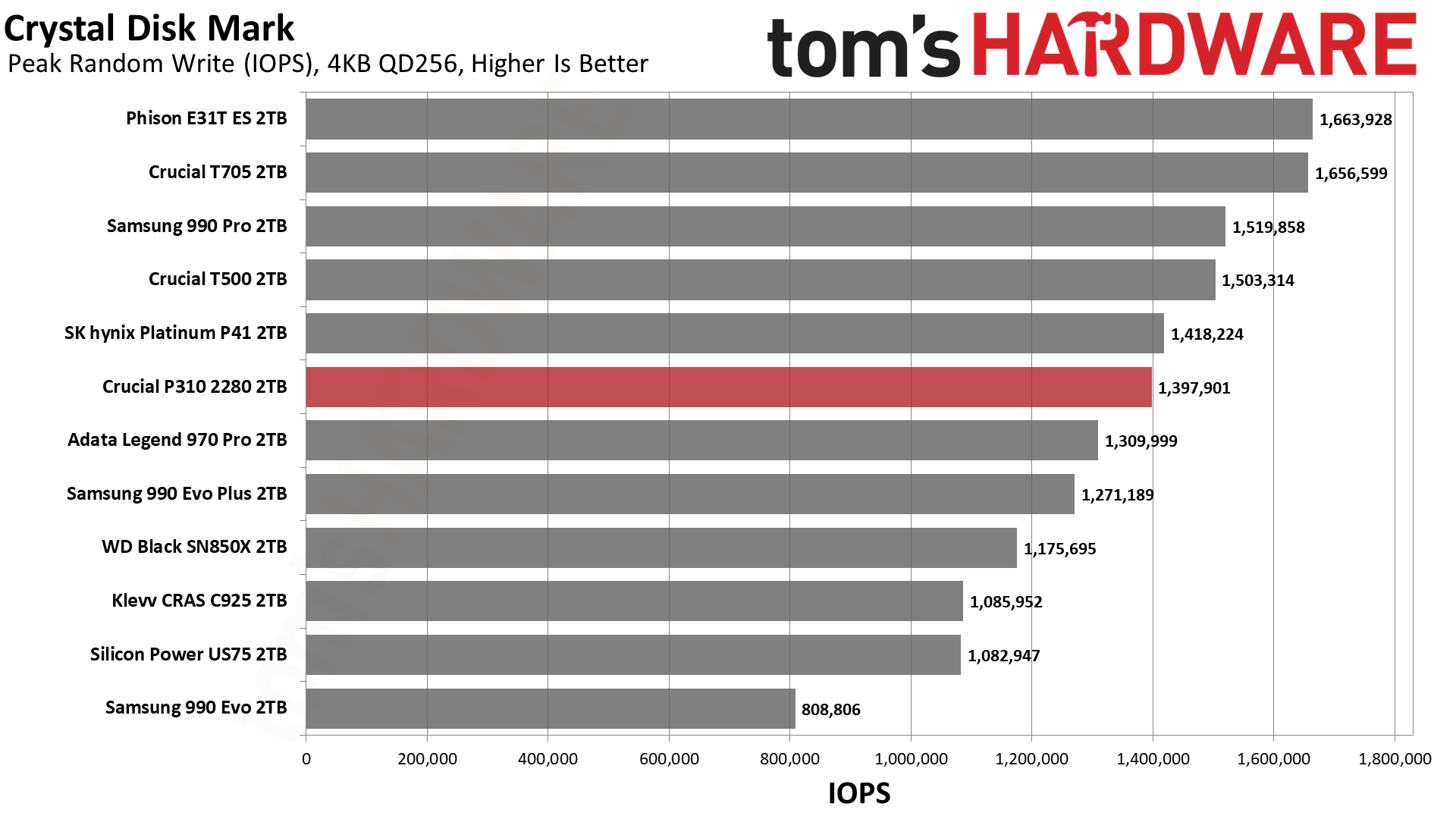
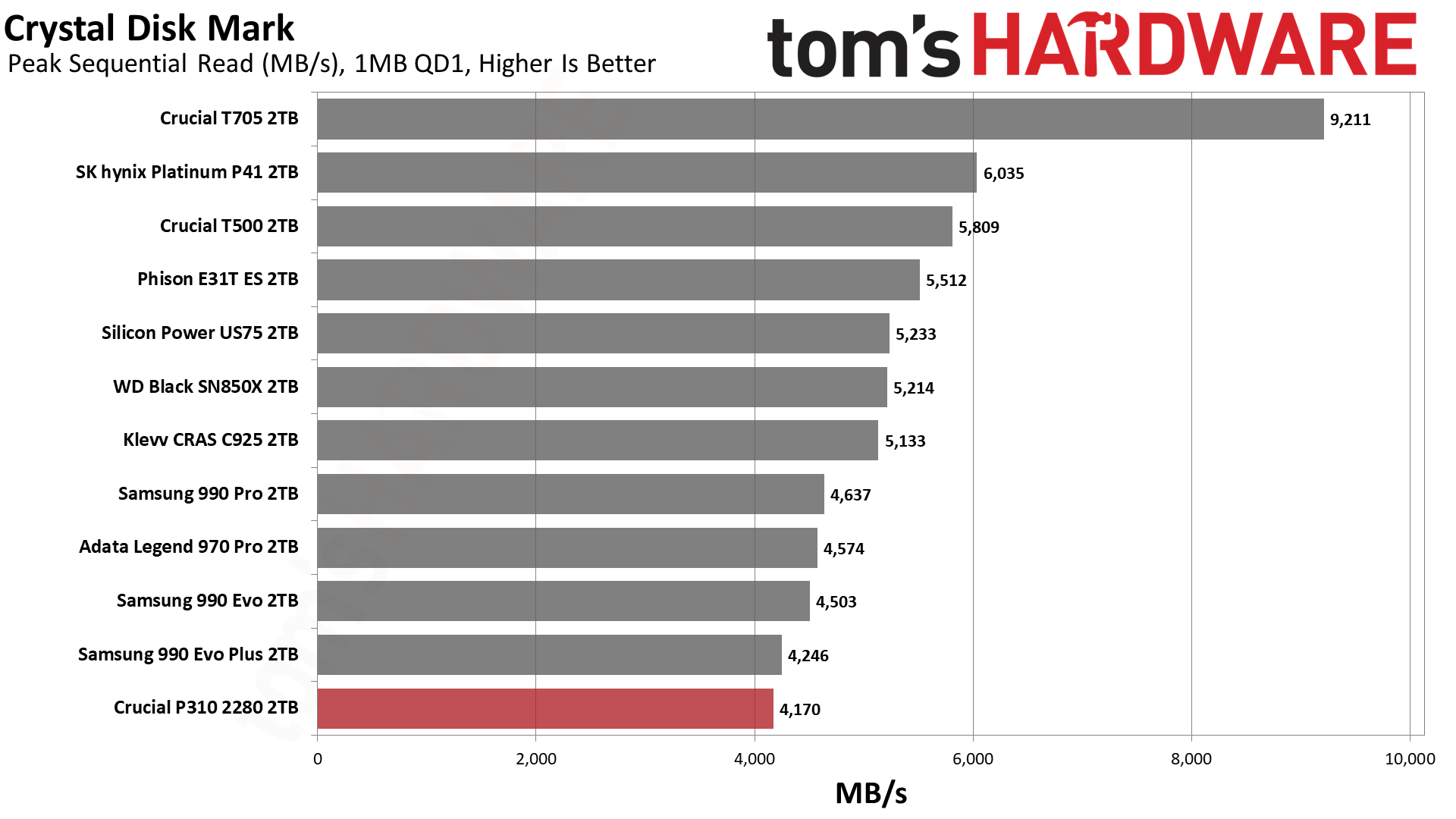
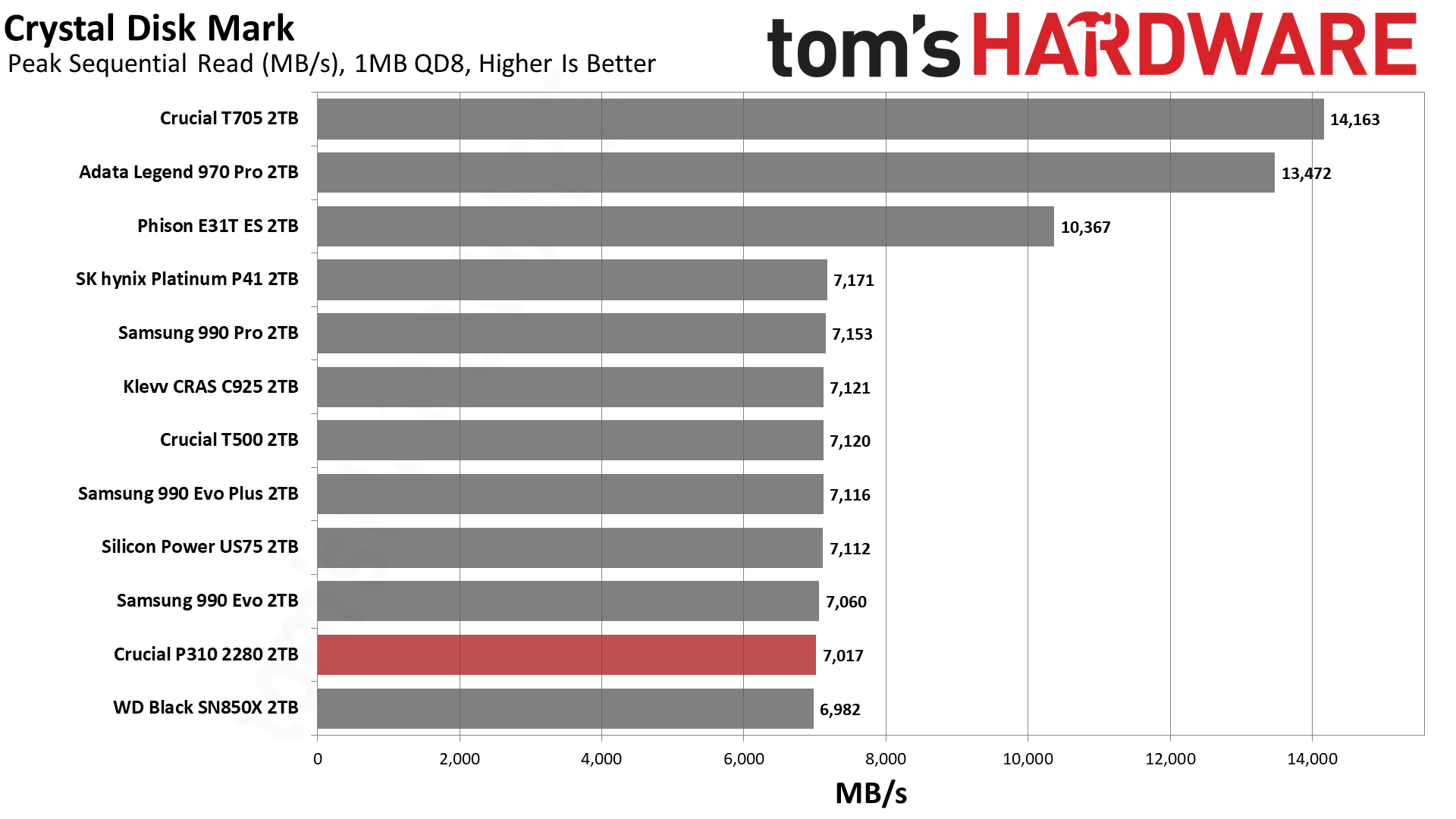
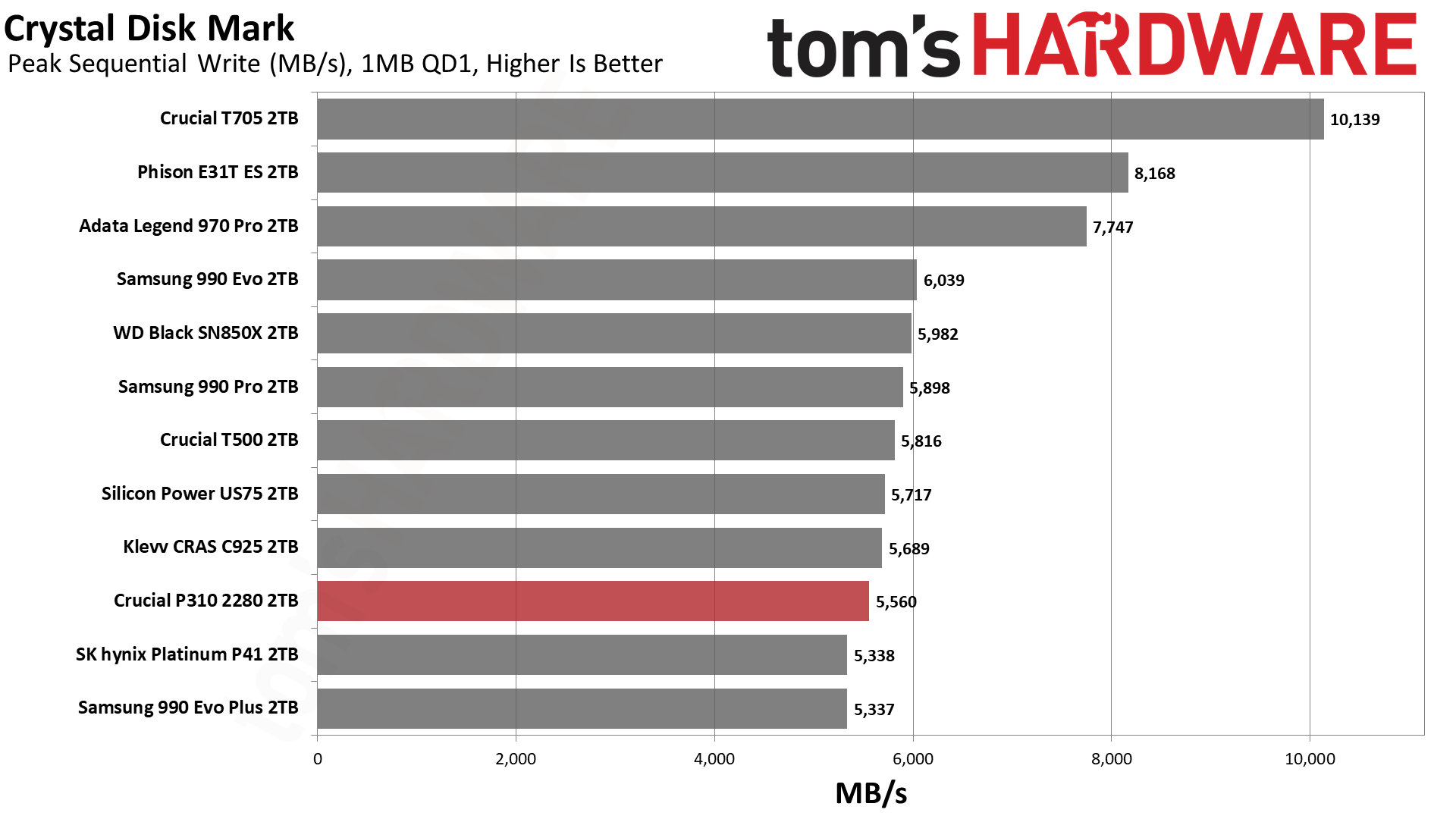
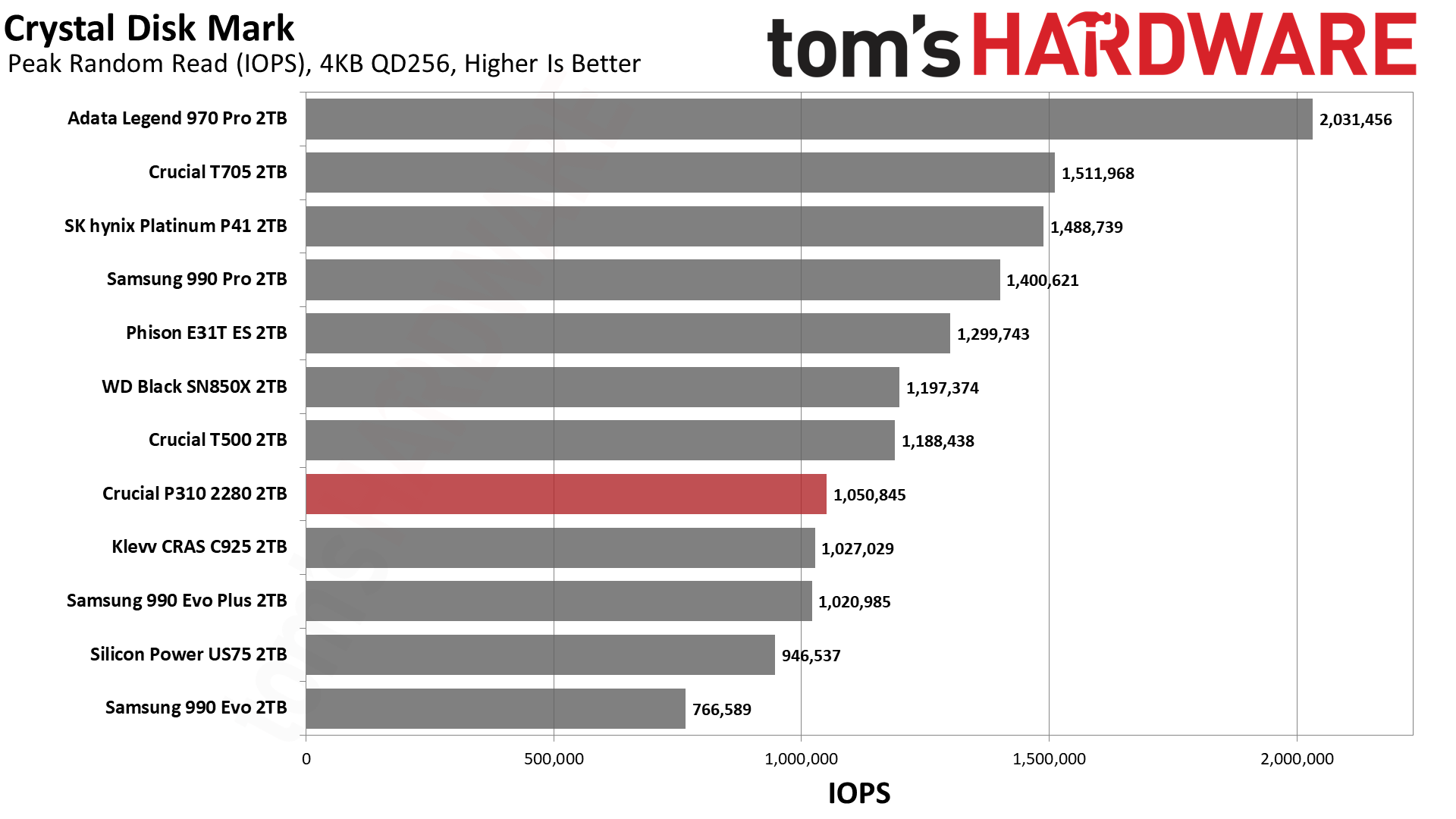
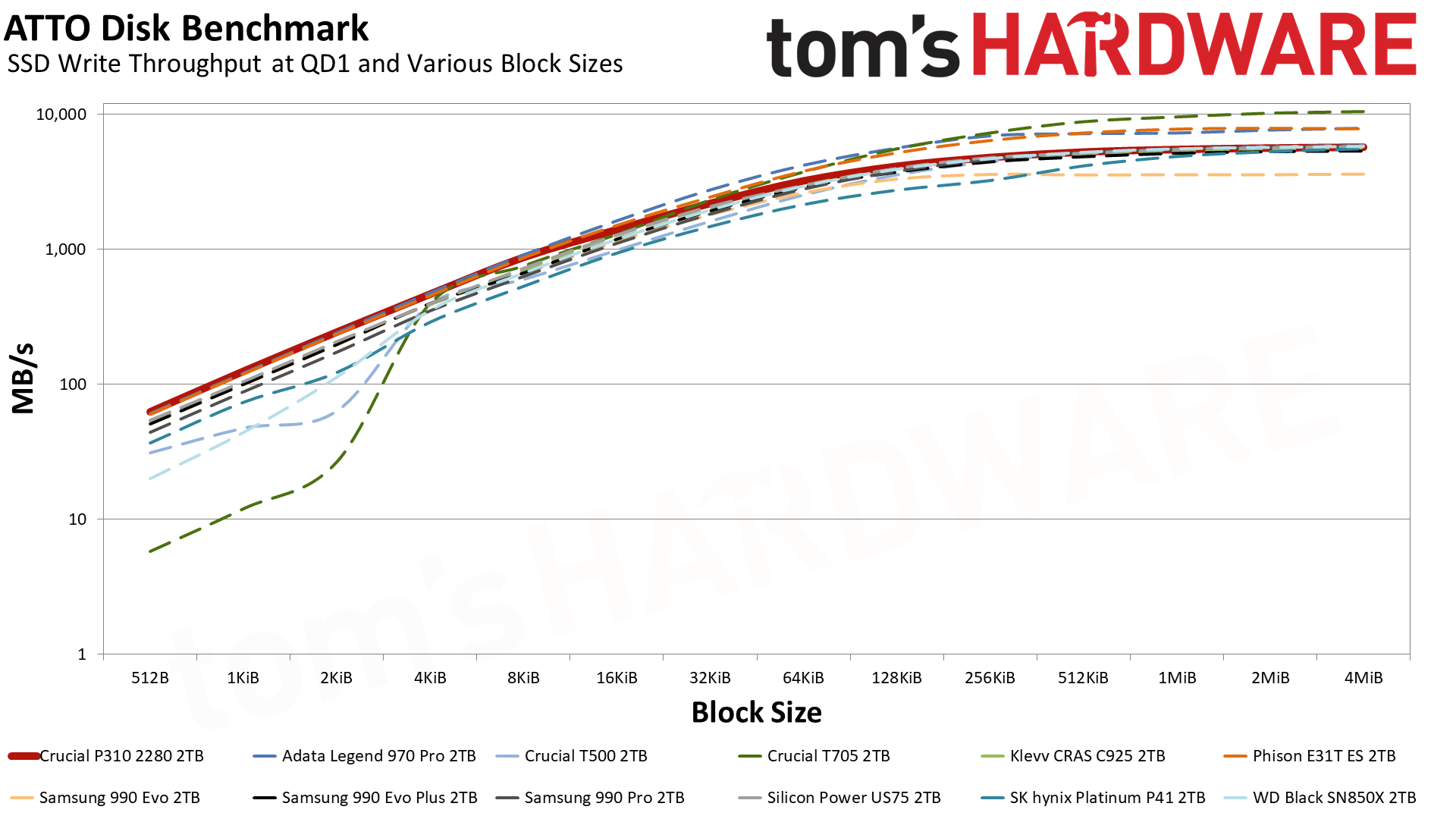
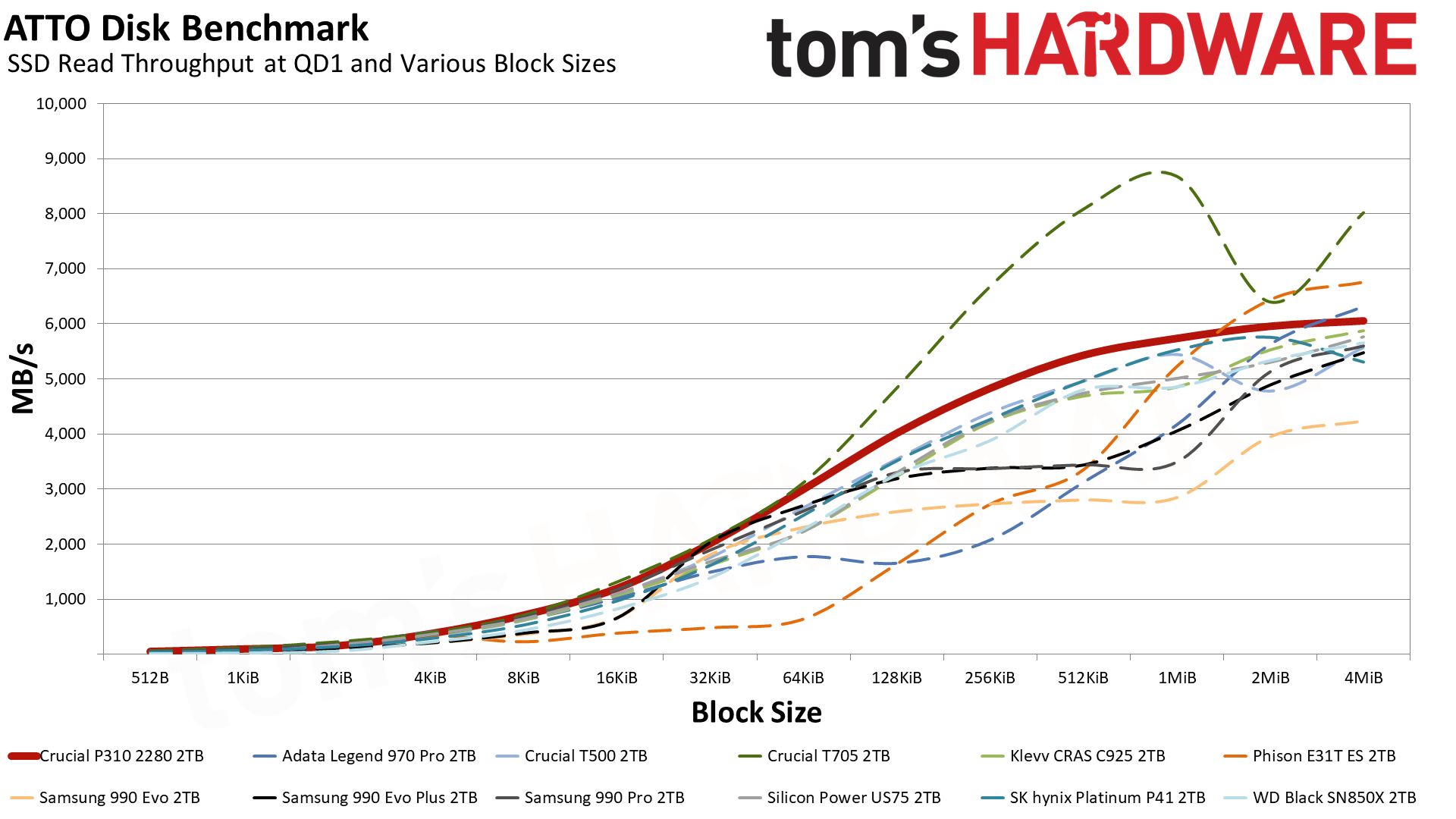
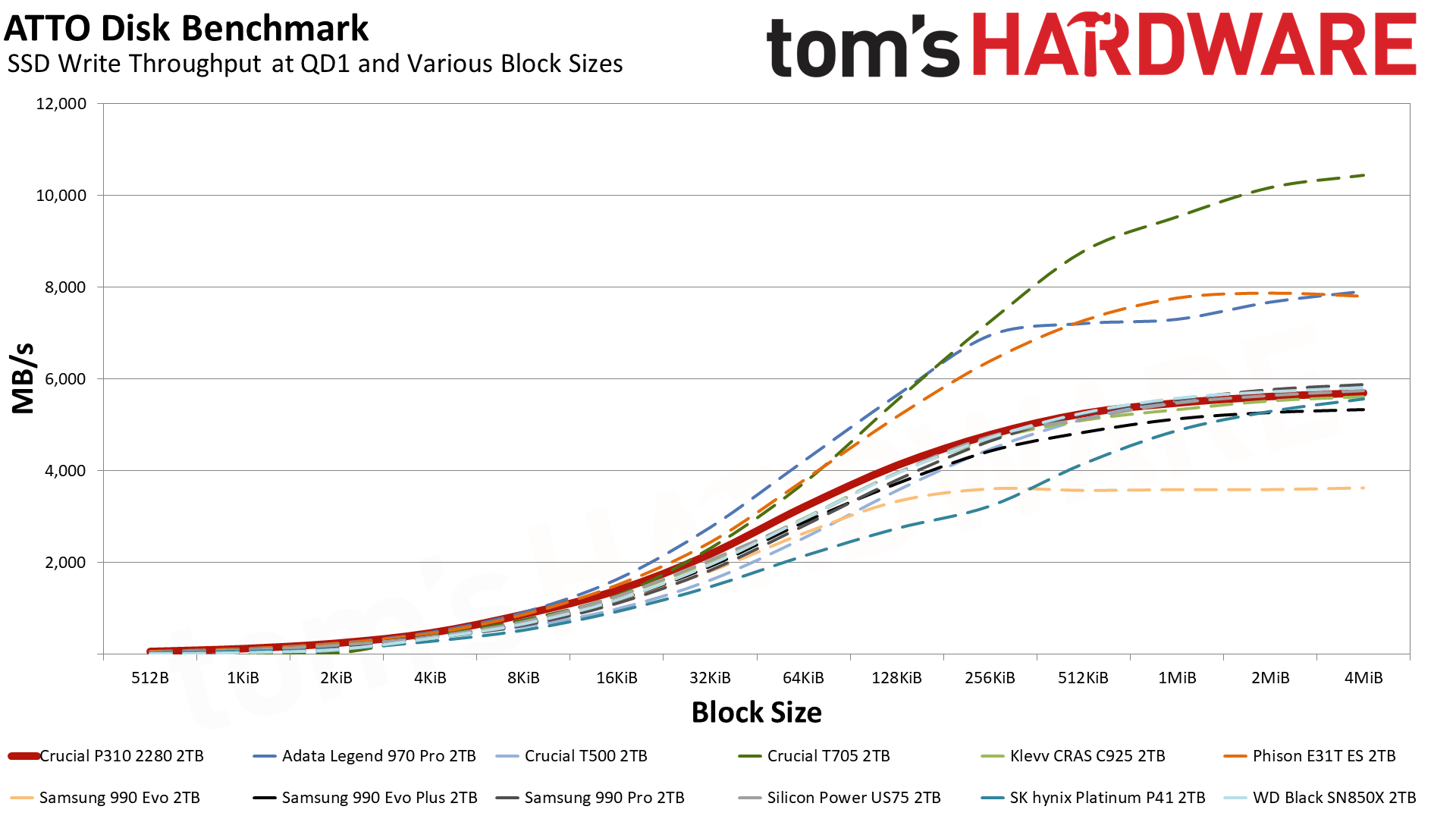
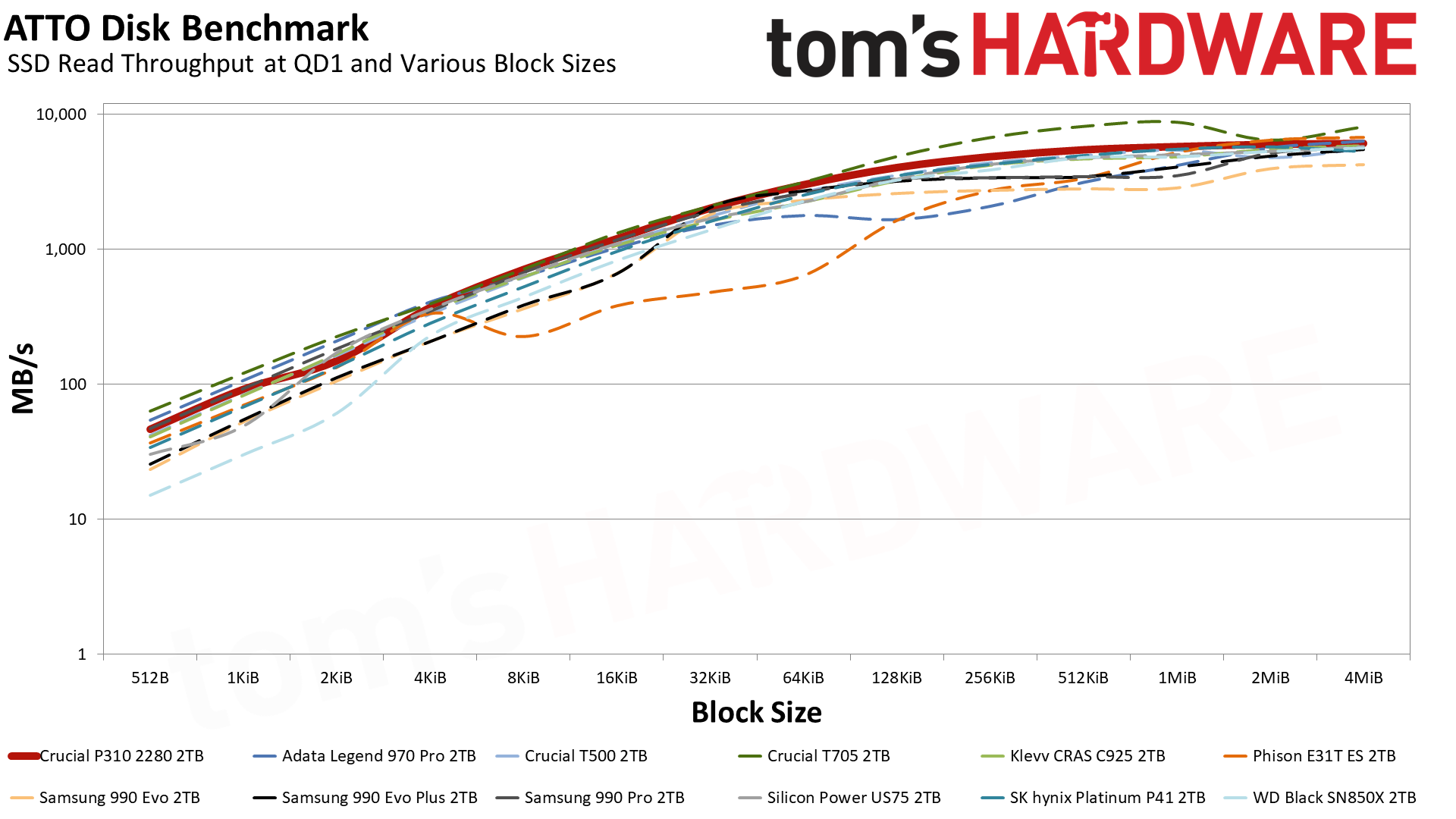
The P310 2280’s ATTO curves are smooth with good performance at all block sizes. Sequential performance in CDM is not as rosy, as the drive’s QLC flash limits what it can do against the TLC-based competition. We think its performance is still good enough. For a drive of this class, where it’s not really supposed to be doing workloads like sustained writes, small I/O performance — indicated by 4KB, QD1 random latencies — is more important.
The P310 2280 has exceptionally low write latency, and even if this is within the pSLC cache it reflects real-world feel as by far and large your random writes should be cached. Random reads will come from native flash, and while QLC flash is not the fastest there are architectural improvements designed to make it more responsive to such demands. As such, the P310’s read latency is also quite good for its interface speed.
Sustained Write Performance and Cache Recovery
Official write specifications are only part of the performance picture. Most SSDs implement a write cache, which is a fast area of pseudo-SLC (single-bit) programmed flash that absorbs incoming data. Sustained write speeds can suffer tremendously once the workload spills outside of the cache and into the "native" TLC (three-bit) or QLC (four-bit) flash. Performance can suffer even more if the drive is forced to fold, which is the process of migrating data out of the cache in order to free up space for further incoming data.
We use Iometer to hammer the SSD with sequential writes for 15 minutes to measure both the size of the write cache and performance after the cache is saturated. We also monitor cache recovery via multiple idle rounds. This process shows the performance of the drive in various states as well as the steady state write performance.
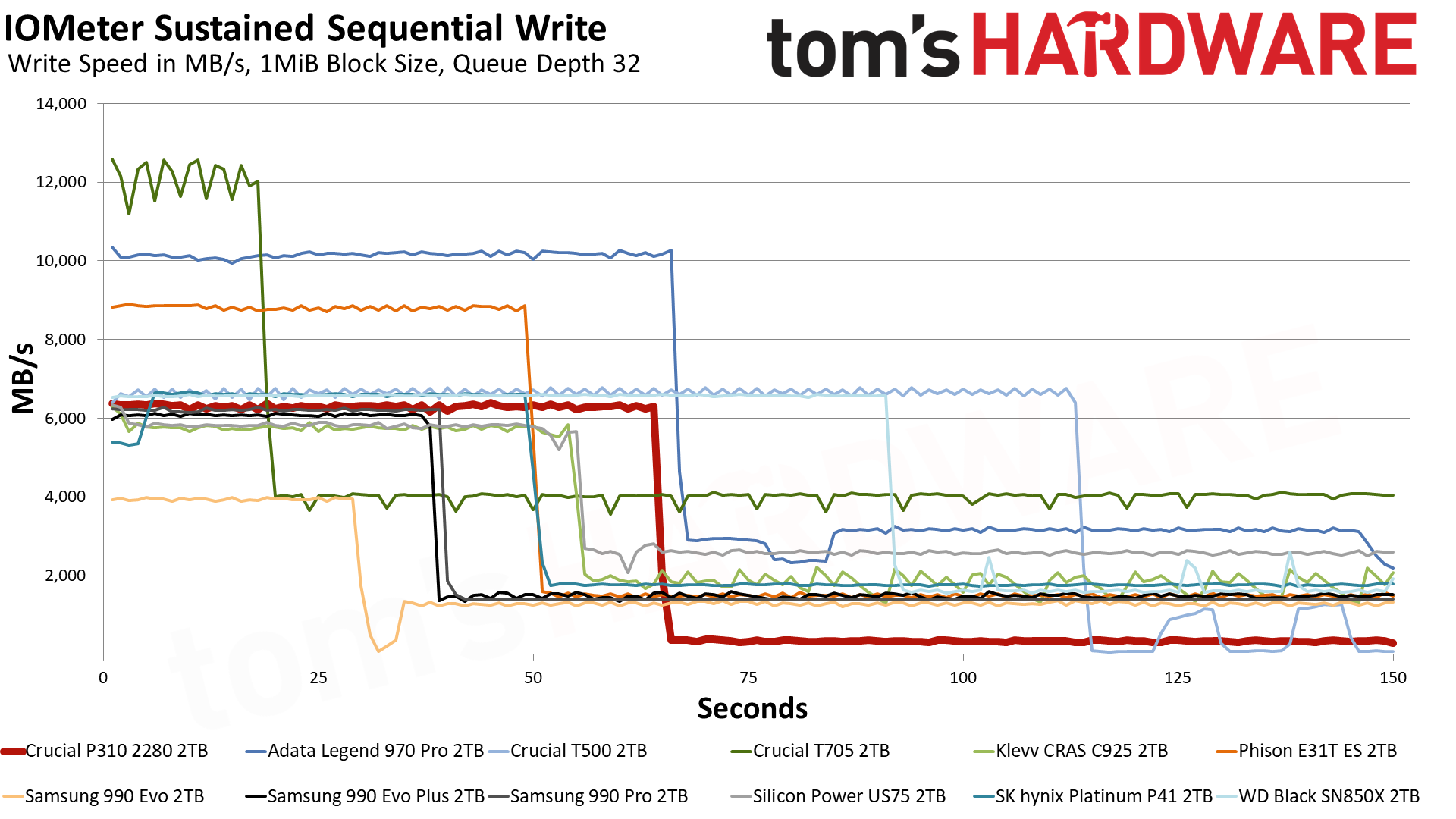
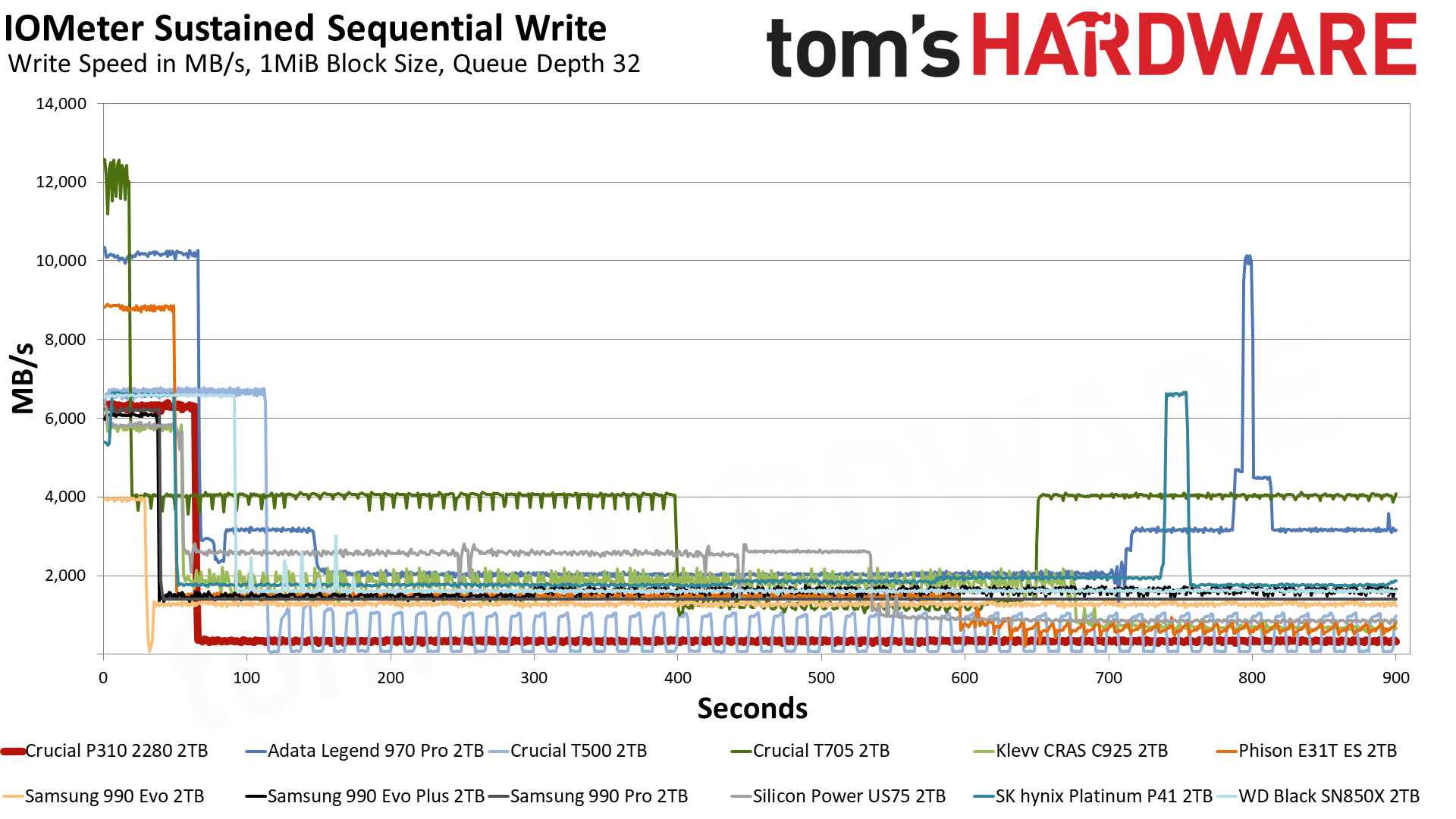
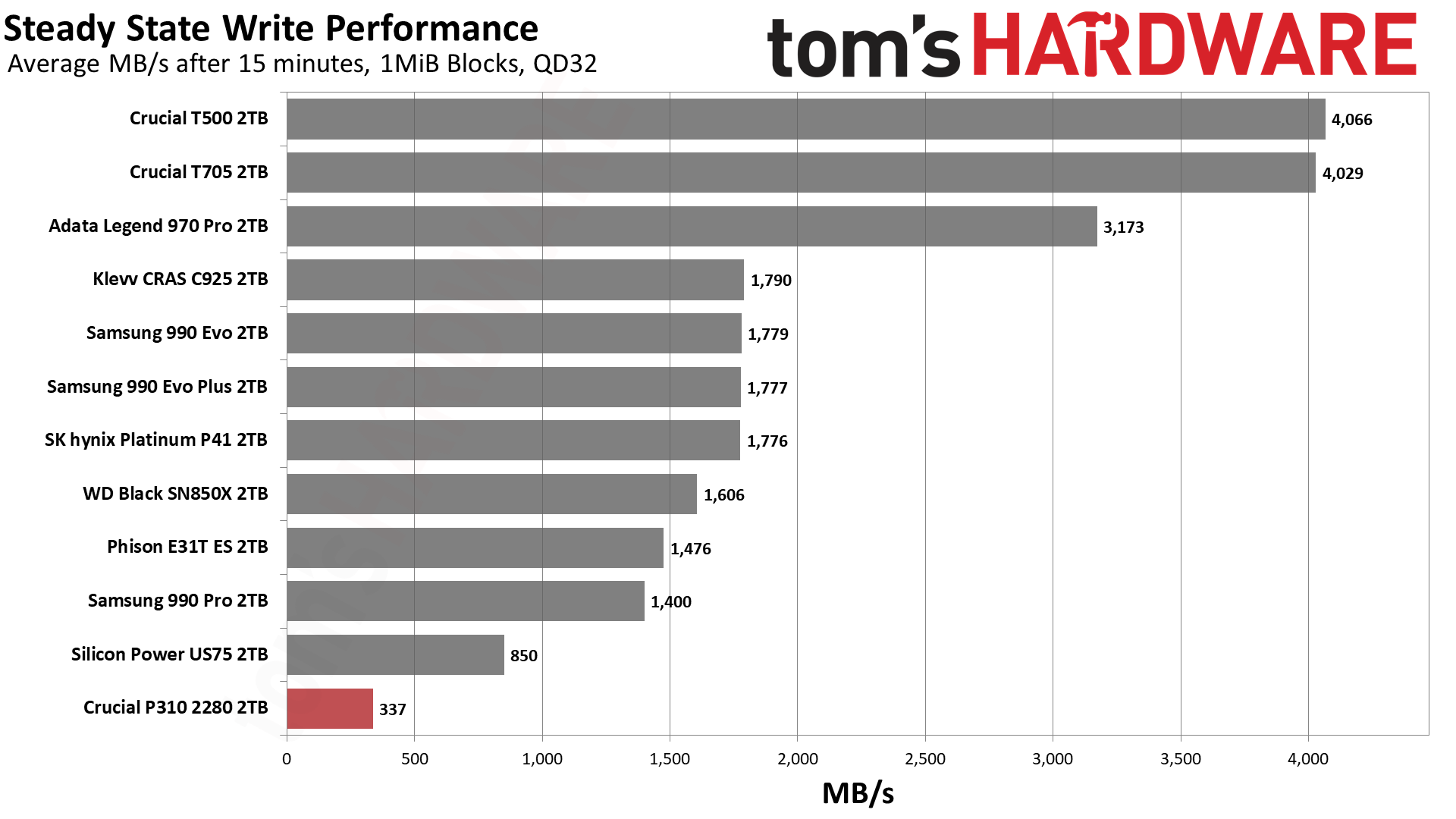
The 2TB P310 writes at 6.3 GB/s for around 64 seconds in the single-bit pSLC cache mode. That makes the cache size around 400GB, which matches pretty well with our findings in the 2230 review. This is a large cache but is not the largest possible. 4-bit QLC flash in a single-bit mode could lead to a cache size of 500GB. By using a smaller cache, the P310 can try and avoid folding — the moving of data from pSLC to QLC flash, which is forced if space must be freed — for a little bit of time, or sustain a higher speed after the cache runs out.
After the cache runs out, the P310 is forced to write to QLC flash while moving data over from pSLC to QLC in order to free up space for incoming and upcoming writes. In this mode it writes at 337 MB/s on average, which is quite slow by most standards. That might seem awful, but it’s better than the 100 MB/s or so we saw with Crucial’s older P3 Plus 2TB.
The newer flash on the P310 is almost twice as fast to write with each die, but it also has 50% more planes and that can cap its interleaving potential sooner. The result is that the 337 MB/s we see here is actually not that bad. Consider that the HP FX700, which has a comparable controller and similar QLC flash from YMTC, only manages 139 MB/s. This suggests that Crucial’s trimming of the pSLC cache is effective in improving sustained performance, even if this is below maximum SATA speeds.
As for recovery, the drive mostly stayed in its slower state even with some idle time. Normally, large-cached drives will recover pSLC rapidly, although this can increase wear. Because Crucial went with a slightly more modest cache it’s able to be more patient, which probably improves the user experience in the long run. One reason for this is that it can retain data in pSLC longer, and that can improve follow-up reads in addition to reducing wear by deferring writes. On the whole, this is a pretty good strategy for a QLC-based drive.
Power Consumption and Temperature
We use the Quarch HD Programmable Power Module to gain a deeper understanding of power characteristics. Idle power consumption is an important aspect to consider, especially if you're looking for a laptop upgrade as even the best ultrabooks can have mediocre stock storage. Desktops may be more performance-oriented with less support for power-saving features, so we show the worst-case.
Some SSDs can consume watts of power at idle while better-suited ones sip just milliwatts. Average workload power consumption and max consumption are two other aspects of power consumption but performance-per-watt, or efficiency, is more important. A drive might consume more power during any given workload, but accomplishing a task faster allows the drive to drop into an idle state more quickly, ultimately saving energy.
For temperature recording we currently poll the drive’s primary composite sensor during testing with a ~22°C ambient. Our testing is rigorous enough to heat the drive to a realistic ceiling temperature.
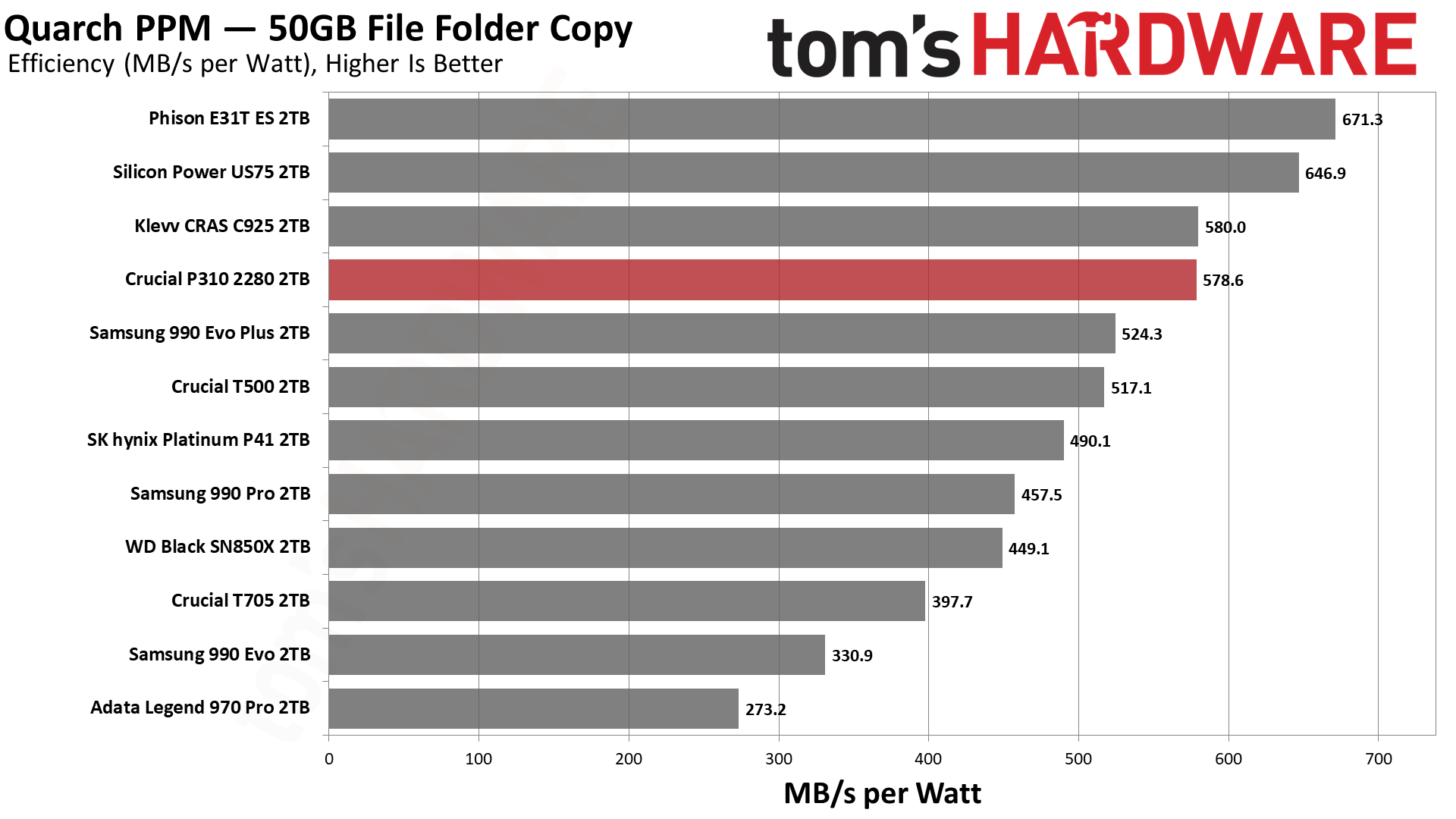
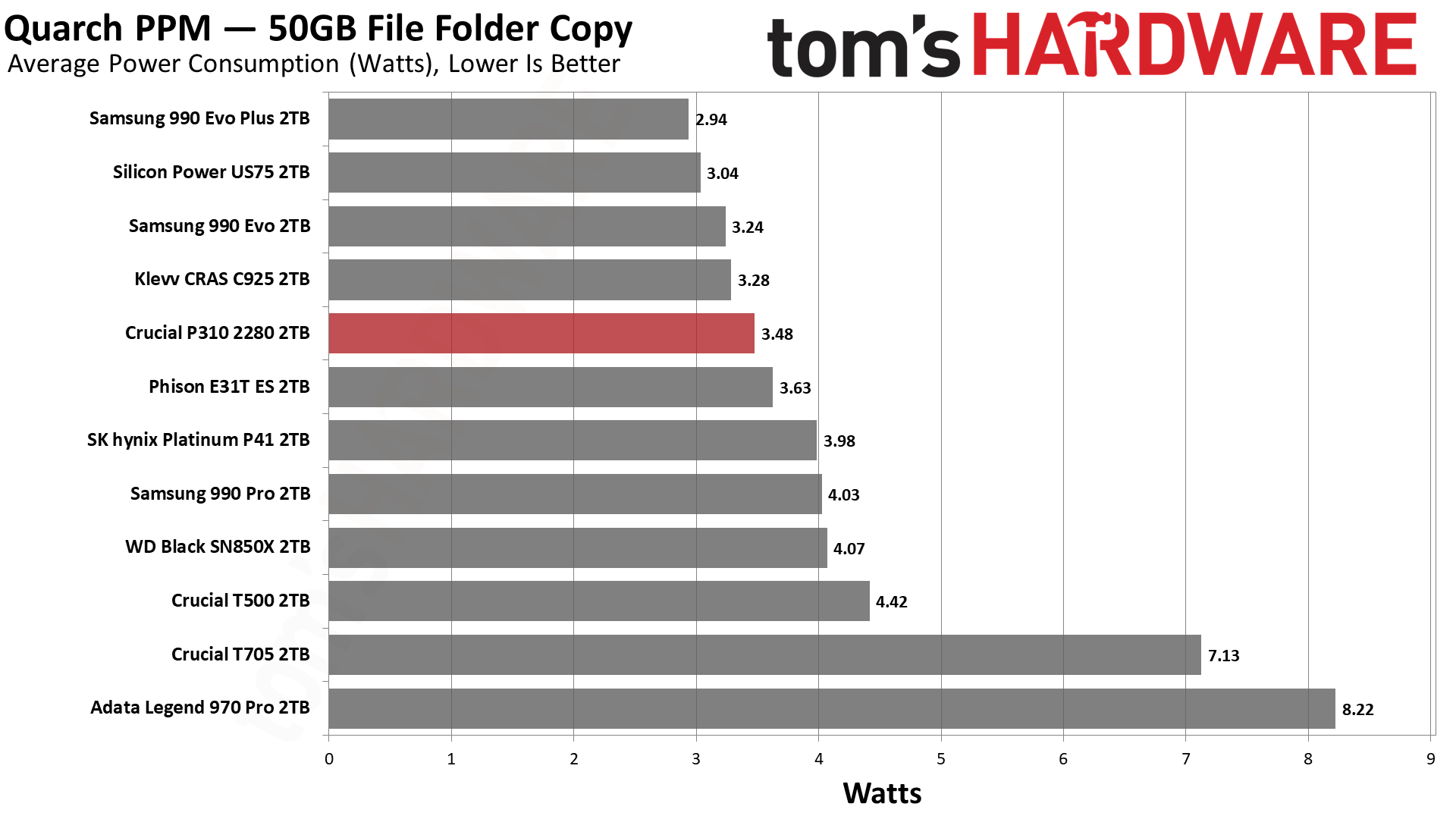
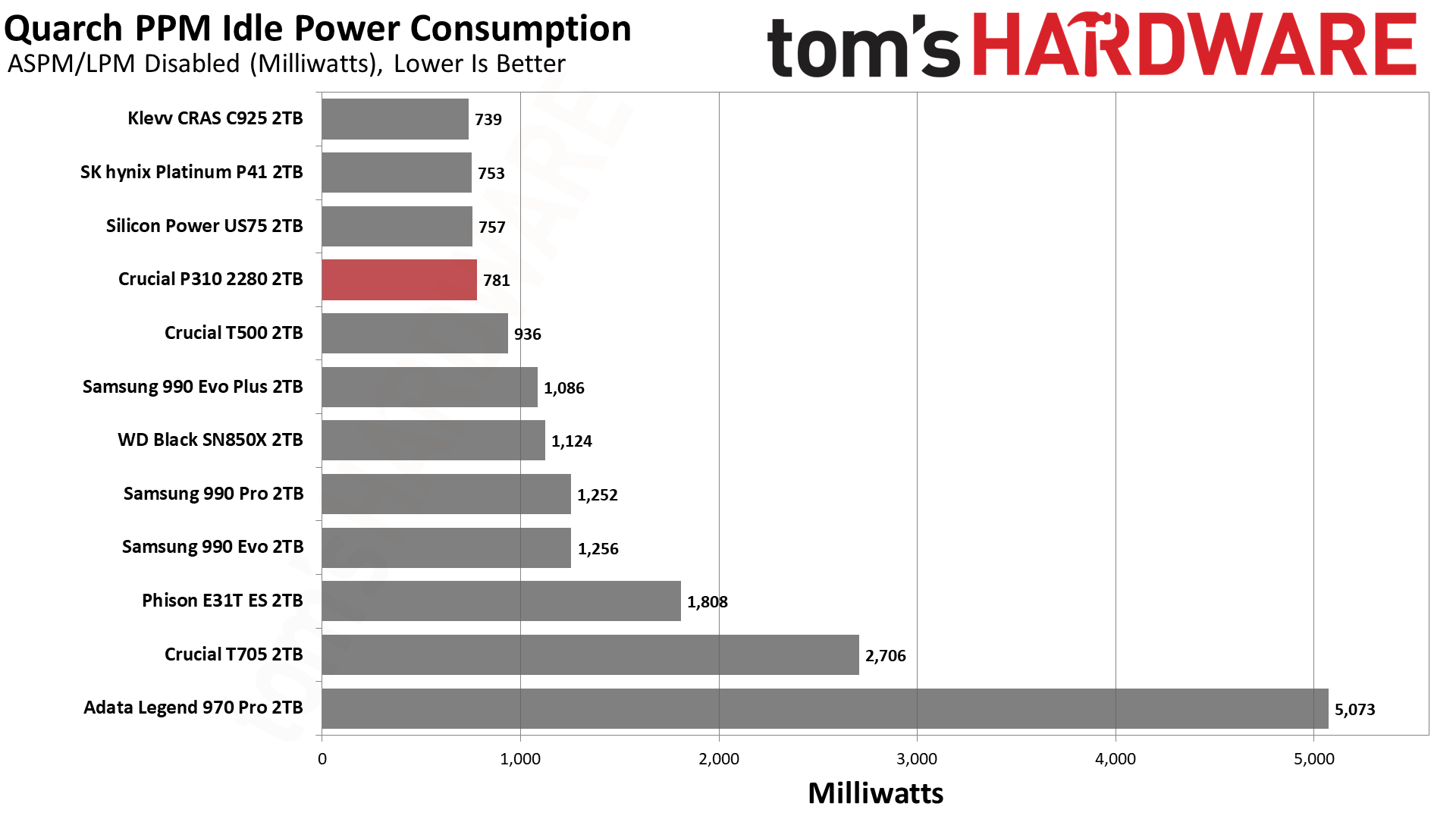
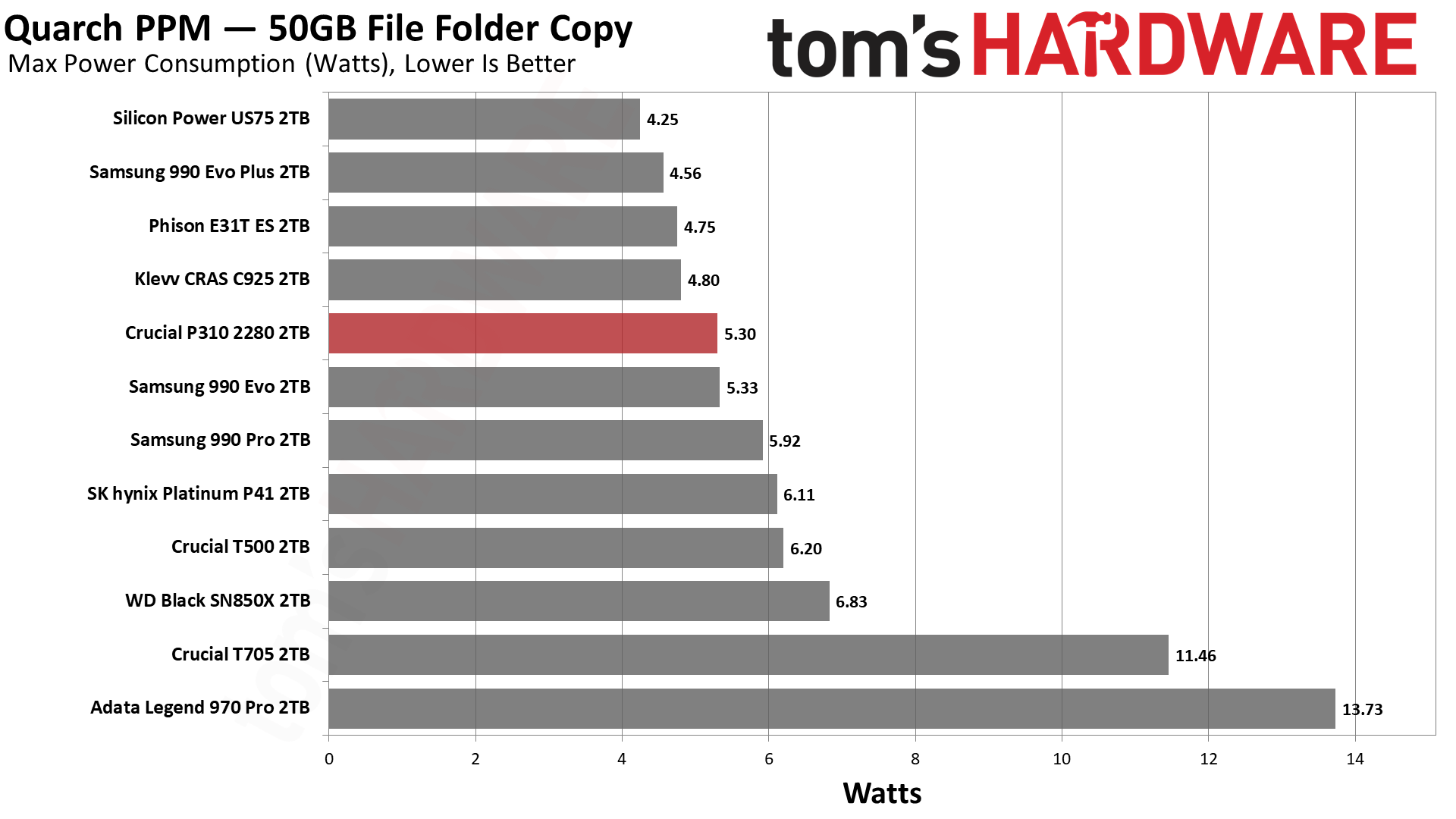
The P310 2280 is very power-efficient, and that’s no surprise. The combination of the excellent Phison E27T controller with the newest QLC flash is bound to produce a drive that doesn’t pull a lot of power. The controller is DRAM-less with only four channels but is still able to max out the PCIe 4.0 interface, allowing the drive to finish workloads quickly. This is especially true with a workload that fits in the pSLC cache. As a result, the P310 is pretty amazing for laptops.
A lower power draw can mean better thermals, too. In our testing the P310 hit a maximum reported temperature of 52°C. This is far below any throttling threshold and this drive should be great when run without a heatsink.
CPU | Row 0 - Cell 2 | |
Motherboard | Row 1 - Cell 2 | |
Memory | Row 2 - Cell 2 | |
Graphics | Intel Iris Xe UHD Graphics 770 | Row 3 - Cell 2 |
CPU Cooling | Row 4 - Cell 2 | |
Case | Row 5 - Cell 2 | |
Power Supply | Row 6 - Cell 2 | |
OS Storage | Row 7 - Cell 2 | |
Operating System | Row 8 - Cell 2 |
We use an Alder Lake platform with most background applications such as indexing, Windows updates, and anti-virus disabled in the OS to reduce run-to-run variability. Each SSD is prefilled to 50% capacity and tested as a secondary device. Unless noted, we use active cooling for all SSDs.
Crucial P310 2280 Bottom Line
The Crucial P310 did not disappoint when we reviewed it in the M.2 2230 form factor, and it doesn’t disappoint now in the larger form factor. Performance is surprisingly good across the board when you consider the drives it’s up against. Sustained performance does remain a problem for QLC-based drives like this, but Crucial does a halfway decent job of mitigating that. Power efficiency is superb, which helps make this drive a great choice for laptops on a budget — or at least it would if the price comes down. The MSRP was way too high for a drive like this — and that’s nothing new, from Crucial or any other manufacturer — but even the street prices remain too high.
This is something it shares in common with the Samsung 990 EVO Plus, an excellent drive that we had to dock half a point due to its pricing and late arrival. Now, the 990 EVO Plus uses TLC flash and as a result has an edge over the P310. We’re merely pointing out how both brands are struggling with the pricing aspect, in part because that’s just how the industry works. You can’t dilute your brand with a low MSRP and the volatile flash and SSD markets mean pricing can be challenging, especially for a new product where inventory is still ramping up.
In any case, docking the P310 2280 half a point over its M.2 2230 sibling has more to do with the fact that the shorter form factor has a lot less competition. 2230 is specialized and the P310 stands out more in comparison to the alternatives. In fact, the 2280 P310 looks somewhat average in this review, but it’s facing some of the fastest drives out there. This is a testament to how good a budget drive can be, even with QLC flash. It would probably stand out more with a 4TB option, but it’s quite good at 2TB and likely would be at 1TB, too. We can safely recommend it for laptops, desktops, and the PS5 at those capacities. 500GB seems like an afterthought, but for an ultra-budget build it could still make sense.
Looking at 2TB and current pricing, we can safely say that the P310 2280 is the best QLC-based drive out there. It’s a known brand with new but known hardware. However, its real competition has TLC flash and this includes drives like the MSI Spatium M482, Lexar NM790 (and newer Lexar Play 2280), Inland TN470, Teamgroup MP44, and more that are at the same price or lower. This is discounting the eight-channel drives with DRAM — some of which are double-sided, and all of which will run hotter in a laptop — as well as lower-end budget PCIe 4.0 drives like the Teamgroup MP44L. If you’re going for a budget PCIe 4.0 drive right now, you might be inclined to look at the top-end 7+ GB/s drives, although on a very tight budget you can get away with the MP44L and drives in its class.
This leaves the P310 2280 in a bit of an odd spot because it feels like a high-end product for what it is, but simultaneously it's designed to be in the budget class of drives. It’s DRAM-less and has QLC flash, which more or less precludes it from being high-end, even when it sometimes performs that way. We suspect it will end up being a popular drive either way, and the price will come down. It’s just a matter of Crucial positioning it correctly, and historically they have been able to do so.
3.5 stars is a good score in our rankings, and the drive holds its own against the competition. However, we know some people will always look down on QLC flash. That’s fine, but anybody looking for a budget SSD that still has some speed — whether as a primary drive for their laptop or budget desktop build, or as a secondary drive, or even in the PS5 — can pick up the P310 2280, install it, and never have to second-guess the decision.
MORE: Best SSDs
MORE: Best External SSDs
MORE: Best SSD for the Steam Deck

Shane Downing is a Freelance Reviewer for Tom’s Hardware US, covering consumer storage hardware.
-
Shiznizzle Reply
I swap games so often that 220 will be done in a little over a year. 1.5 years tops. TBW number is the only one i look at apart from price. If both TBW aand price are good i buy it.Notton said:220TB endurance for that price? no thanks.
Filling up the drive is also not advised so i tend to try to keep my drives at %50 full. I also turned off all log writing when i was on windows. Dont know how to do that in linux yet so the thing is prolly being written to all day long.
Just bought a 2 TB Samsung EVO plus.....for 105 pounds. 1200 TBW rating Some WD have 2400
